

Rhyme Scheme

Rhyme Scheme Definition
What is a rhyme scheme? Here’s a quick and simple definition:
A rhyme scheme is the pattern according to which end rhymes (rhymes located at the end of lines) are repeated in works poetry . Rhyme schemes are described using letters of the alphabet, such that all the lines in a poem that rhyme with each other are assigned a letter, beginning with "A." For example, a four-line poem in which the first line rhymes with the third line , and the second line rhymes with the fourth line has the rhyme scheme A B A B , as in the poem "Roses are red , / Violets are blue . / Shakespeare is dead ? / I had no clue ."
Some additional key details about rhyme schemes:
- Rhyme schemes represent stanza breaks using spaces. So a poem made up of two rhyming couplets (two-line stanzas) would be said to have a rhyme scheme of AA BB.
- There are different conventions for writing out rhyme schemes. Some people use lowercase letters (abab), some use uppercase (ABAB), and some even throw in italics or hyphens ( a-b-a-b ). This formatting aspect of rhyme schemes is not very scientific.
- Rhymes are used in all types of poetry, but they don't always occur in regular patters or at the ends of lines—so not all poems that use rhyme necessarily have rhyme schemes. Rhyme schemes are only used to describe poems that use end rhyme (that is, rhymes at the ends of lines).
Types of Rhyme Schemes
A poem's rhyme scheme can be anything the poet wants it to be, but here's a list of some of the more common rhyme schemes:
- Alternate rhyme is ABAB CDCD EFEF and so on. This is the rhyme scheme typically used in ballads .
- Coupled rhyme is any rhyme scheme in which rhymes occur in pairs, such as AABBCC. The rhymes themselves are called couplets.
- Monorhyme is the term used for poems that use just one rhyme throughout the entire poem, as in AAAA.
- Enclosed rhyme is the term used for "sandwich" rhyme schemes like ABA or ABBA.
- Simple 4-line rhyme follows a pattern of ABCB.
- Chain rhyme describes rhyme schemes in which stanzas are linked together by rhymes that carry over from one stanza to the next, as in ABA BCB CDC.
Keep in mind that this is just a list of some of the more common types of rhyme scheme. It's not a list of all the different forms of poetry, since the form of a poem is defined by more than just its rhyme scheme.
Rhyme Scheme and Formal Verse
Generally speaking, poems that have rhyme schemes are written in what's known as formal verse (which is the name given to rhymed poetry that uses a strict meter ). All formal verse poems have some sort of rhyme scheme.
In addition, certain forms of poems, such as sonnets or villanelles have a pre-determined rhyme scheme. Poets wanting to write such poems have to match the rhyme scheme they use to the rhyme scheme defined by the type of poem in question.
Single-Stanza vs. Whole-Poem Rhyme Schemes
The pattern of a rhyme scheme can be specific to a single stanza of a poem, or it can repeat throughout an entire poem. For instance, if a poem is said to have an ABAB rhyme scheme, that might mean that the same two rhymes are used throughout the whole poem (as in, ABAB ABAB ABAB), but this is pretty uncommon in English—so more likely than not it's just a shorthand way of saying that each stanza uses a rhyme scheme of ABAB, but the A and B rhymes are not actually the same between stanzas. In this case, a longer poem with an ABAB rhyme scheme, if you were to write it out, would actually be ABAB CDCD EFEF, and so on. If you're not sure whether a rhyme scheme is supposed to apply to a whole poem or just a single stanza, the easiest way to figure this out is to just check the poem to see if rhymes are the same between different stanzas.
There are really only a few circumstances in which it makes sense to write out the entire rhyme scheme of a poem from beginning to end (instead of just using the single-stanza rhyme scheme as shorthand): when describing "fixed verse forms," or poems with a predetermined number of lines and a fixed rhyme scheme, such as a sonnet . Sonnets are 14-line poems that typically use a rhyme scheme of ABBA ABBA CDEDCE—so in this case, writing out the rhyme scheme of the entire poem is actually the most efficient way of describing it.
Other fixed verse forms, such as the villanelle , are easier to describe using simple English, as in, "five tercets with an ABA rhyme scheme, plus a final quatrain with a rhyme scheme of ABAA." That's less tedious and much easier on the eyes than writing "villanelles use a rhyme scheme of ABA ABA ABA ABA ABA ABAA," though both ways of describing a villanelle's rhyme scheme are acceptable.
Perfect Rhyme, Imperfect Rhyme, and Rhyme Scheme
Most people, when they think about what constitutes a rhyme, are actually thinking about one type of rhyme in particular, called perfect rhyme , which only includes words with identical sounds like "game" and "tame," or "table" and "fable." But in fact, rhyme is a rather broad and loosely-defined literary device that includes many different types of repetition of sounds between words. For instance, the words "crate" and "braid" make a specific type of rhyme called slant rhyme , because they both share a vowel sound ("ay") in their final syllable. When it comes to rhyme schemes and how they're written out, poems that use imperfect rhymes are no different from poems that use perfect rhymes. Therefore, this excerpt from a poem by Yeats would be said to have an A B A B rhyme scheme even though it uses slant rhyme:
When have I last looked on The round green eyes and the long wavering bodies Of the dark leopards of the moon ? All the wild witches, those most noble ladies
Refrains and Rhyme Schemes
Some types of poems, such as ballades , have entire lines that repeat at regular intervals throughout the poem. These repeating lines are called refrains . For poems that use refrains, it's common to write the rhyme scheme in lowercase letters and then to use an uppercase letter to indicate the refrain. For example, ballades consist of three eight-line stanzas with a rhyme scheme of ababbcbC, plus a final four-line stanza with a rhyme scheme of bcbC, where the final line of every stanza is the refrain.
Rhyme Scheme Examples
The following examples show all sorts of different rhyme schemes.
Coupled Rhyme in Dr. Seuss's Horton Hears a Who!
Dr. Seuss wrote many of his children's books in formal verse . The opening stanza of his book Horton Hears a Who , excerpted below, uses a simple rhyme scheme of coupled rhyme (AABB).
On the fifteenth of May, in the jungle of Nool , In the heat of the day, in the cool of the pool , He was splashing... enjoying the jungle's great joys ... When Horton the elephant heard a small noise .
Chain Rhyme in Frost's "Stopping by Woods on a Snowy Evening"
In the excerpt of Frost's poem shown here, the B rhyme of the first stanza is taken up as the predominant rhyme in the second stanza, while the C rhyme in the second stanza then becomes the predominant line in the third stanza—making the rhyme scheme an example of chain rhyme (in which stanzas are linked together by rhymes that carry over from one stanza to the next).
Whose woods these are I think I know . His house is in the village though ; He will not see me stopping here To watch his woods fill up with snow . My little horse must think it queer To stop without a farmhouse near Between the woods and frozen lake The darkest evening of the year . He gives his harness bells a shake To ask if there is some mistake . The only other sound’s the sweep Of easy wind and downy flake .
Milton's "When I Consider How My Light is Spent"
This sonnet by John Milton follows the traditional rhyme scheme of Italian sonnets: A BB A A BB A C D E C D E .
When I consider how my light is spent Ere half my days in this dark world and wide , And that one talent which is death to hide Lodg'd with me useless, though my soul more bent To serve therewith my Maker, and present My true account, lest he returning chide ; "Doth God exact day-labour, light denied ?" I fondly ask. But Patience to prevent That murmur, soon replies: "God doth not need Either man's work or his own gifts; who best Bear his mild yoke, they serve him best. His state Is kingly. Thousands at his bidding speed And post o'er land and ocean without rest : They also serve who only stand and wait ."
Andrew Lang's "Ballade to an Optimist"
This poem follows the standard form of the ballade . It has three stanzas of eight lines each, a four-line final stanza, and a refrain in the last line of each stanza. It uses the typical ballade rhyme scheme of a b a bb c b C for the eight-line stanzas and b c b C for the final stanza.
And, sometimes on a summer's day To self and every mortal ill We give the slip, we steal away , To walk beside some sedgy rill : The darkening years, the cares that kill , A little while are well forgot ; When deep in broom upon the hill , We'd rather be alive than not . What though we wish the cats at play Would some one else's garden till ; Though Sophonisba drop the tray And all our worshipped Worcester spill , Though neighbours "practise" loud and shrill , Though May be cold and June be hot , Though April freeze and August grill , We'd rather be alive than not . And, sometimes on a summer's day To self and every mortal ill We give the slip, we steal away , To walk beside some sedgy rill : The darkening years, the cares that kill , A little while are well forgot ; When deep in broom upon the hill , We'd rather be alive than not . Pistol, with oaths didst thou fulfil The task thy braggart tongue begot , We eat our leek with better will , We'd rather be alive than not .
Oscar Wilde's "The Ballad of Reading Gaol"
This poem by Oscar Wilde is a variation on a traditional ballad . It uses a six-line stanza instead of the ballad's usual four-line stanza, and it has an " A B C B D B " rhyme scheme.
He did not wear his scarlet coat , For blood and wine are red , And blood and wine were on his hands When they found him with the dead , The poor dead woman whom he loved , And murdered in her bed . He walked amongst the Trial Men In a suit of shabby grey ; A cricket cap was on his head , And his step seemed light and gay ; But I never saw a man who looked So wistfully at the day .
It's worth noting that this is an example of a rhyme scheme that applies at the level of the stanza rather than the whole poem. Therefore, the "A" rhyme of the first stanza doesn't rhyme with the "A" rhyme of the second stanza, the "B" rhyme of the first stanza doesn't rhyme with the "B" rhyme of the second stanza, and so forth. When we say the rhyme scheme is "ABCBDB," that's just shorthand for ABCBDB EFGFHF, etc.
Why Do Writers Use Rhyme Schemes?
Poets use rhyme schemes for many of the same reasons they use rhyme: because it makes language sound more beautiful and thoughtfully-composed, like music. In the majority of rhyme schemes, rhymes repeat at regular intervals, dramatically increasing both the rhythm and musicality of poetry and in the process making the poem more pleasant to listen to, easier to understand, and more memorable.
Poets also choose specific rhyme schemes for different purposes. For instance, rhyme schemes in which rhymes are coupled (AABB) or in which they alternate (ABAB) tend to feel highly predictable and repetitive, which makes them well-suited to children's books and songs. However, after a while these rhyme schemes can start to seem a bit simplistic and tiresome. For that reason, poets who consider their work to be more literary or complex might choose to write in a poetic form that uses a more elaborate rhyme scheme (such as the sestina ), both as a way of challenging themselves, and as a way of using rhyme more subtly in their work.
Other Helpful Rhyme Scheme Resources
- The Wikipedia Page on Rhyme Scheme: A somewhat technical explanation, including various helpful examples.
- An article that covers some of the most basic rhyme schemes and links to examples of poems that use them.
- A short video that explains rhyme scheme and shows how to label rhymes.
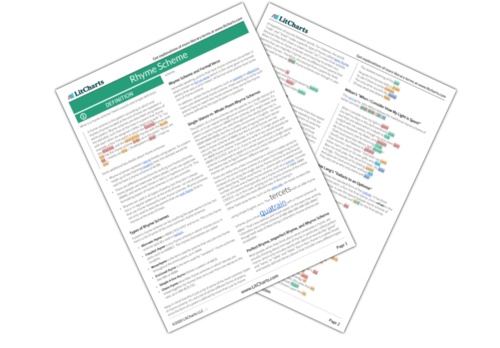
- PDFs for all 136 Lit Terms we cover
- Downloads of 1916 LitCharts Lit Guides
- Teacher Editions for every Lit Guide
- Explanations and citation info for 40,380 quotes across 1916 books
- Downloadable (PDF) line-by-line translations of every Shakespeare play
- Formal Verse
- Slant Rhyme
- Flat Character
- Anachronism
- End-Stopped Line
- Polysyndeton
- Deus Ex Machina
- Colloquialism
- Bildungsroman

Rhyme Scheme
Definition of rhyme scheme.
Rhyme scheme is the pattern of rhyme that comes at the end of each verse or line in poetry. In other words, it is the structure of end words of a verse or line that a poet needs to create when writing a poem . Many poems are written in free verse style . Some other poems follow non-rhyming structures, paying attention only to the number of syllables. The Japanese genre of Haiku is a case in point. Thus, it shows that the poets write poems in a specific type of rhyme scheme or rhyming pattern. There are several types of rhyme schemes as given below.
Types of Rhyme Scheme
There are a number of rhyme schemes used in poetry; some of the most popular of which include:
- Alternate rhyme : It is also known as ABAB rhyme scheme, it rhymes as “ABAB CDCD EFEF GHGH.”
- Ballade : It contains three stanzas with the rhyme scheme of “ABABBCBC” followed by “BCBC.”
- Monorhyme : It is a poem in which every line uses the same rhyme scheme.
- Couplet : It contains two-line stanzas with the “AA” rhyme scheme, which often appears as “AA BB CC and DD…”
- Triplet : It often repeats like a couplet , uses rhyme scheme of “AAA.”
- Enclosed rhyme : It uses rhyme scheme of “ABBA”
- Terza rima rhyme scheme : It uses tercets, three lines stanzas. Its interlocking pattern on end words follows: ABA BCB CDC DED and so on.
- Keats Odes rhyme scheme : In his famous odes, Keats has used a specific rhyme scheme, which is “ABABCDECDE.”
- Limerick : A poem uses five lines with a rhyme scheme of “AABBA.”
- Villanelle : A nineteen-line poem consisting of five tercets and a final quatrain . It uses a rhyme scheme of “A1bA2, abA1, abA2, abA1, abA2, abA1A2.”
Short Examples of Rhyme Scheme
- The sun is shining bright This is a lovely sight.
- You are like a day of May And I as worthless as hay.
- This is poor Mr. Potter Walking a road with his daughter.
- Sometimes, your unspoken word Is more important than that heard.
- Little boy wants to eat cakes Whenever he from sleep awakes.
- I saw a tree that to God doth say I want the Lord to accept my pray.
- I think I can never see Something as free as a sea.
- After so many days of drought down poured the rain It took so long is if came from Spain.
- The green garden lets its shade fall Over the red old school hall.
- There flows the river That’s amongst the greatest giver.
Rhyme Scheme and Formal Verse
Rhyme scheme is an integral part of formal verse. The formal verse means poetry is written using a strong metrical pattern and proper rhyme scheme. For example, sonnets , odes, and lyrics are formal verses. Epic poems are also considered an example of formal verse. It means that the rhyme scheme is an element of formal verse. It is because the verses are rhyming at the ending words that makes the poem have melody and music. On the other hand, free verse is not formal poetry and hence is devoid of rhyme scheme. That is why free verse does not have melody and music as formal verse has.
Difference Between Perfect Rhyme and Imperfect Rhyme aka Slant Rhyme
In poetic language or poetry, perfect rhyme is that in which a stressed vowel in two words or phrases occurring close to each other is similar. This is also called exact rhyme , while some critics also call it true rhyme, or full rhyme. One more difference is that there is one stressed syllable that differs in some cases such as leave and believes has one different syllable, while in trouble and bubble, there is a similarly stressed vowel sound.
Contrary to the perfect rhyme, a slant rhyme or imperfect rhyme in which words could be similar, but they are not similar in sounds. In most cases, the vowel segments are entirely different, or consonants could sound similar. This is also called lazy rhyme or near rhyme.
Examples of Rhyme Scheme in Literature
Let us take a few examples of the most widely used rhyme schemes in literature:
Example #1: Neither Out Far nor in Deep (By Robert Frost)
The people along the sand (A) All turn and look one way. (B) They turn their back on the land. (A) They look at the sea all day. (B) As long as it takes to pass (C) A ship keeps raising its hull; (C) The wetter ground like glass (D) Reflects a standing gull. (D)
This is an ABAB pattern of rhyme scheme, in which each stanza applies this format. For instance, in the first stanza, “sand” rhymes with the word “land,” and “way” rhymes with the word “day.”
Example #2: Twinkle Twinkle Little Star (By Donald Barthelme)
Twinkle, Twinkle, Little Star , (A) How I wonder what you are. (A) Up above the world so high, (B) Like a diamond in the sky. (B)
The following example uses an AABB rhyme scheme. Here, the first line ends in the word “star,” which rhymes with the final word of the second line, “are.” Since both words rhyme with each other, they are signified with letter “A.”
Example #3: Divine Comedy (By Dante Alighieri)
As I drew nearer to the end of all desire, (A) I brought my longing’s ardor to a final height, (B) Just as I ought. My vision, becoming pure, (A) Entered more and more the beam of that high light (B) That shines on its own truth. From then, my seeing (C) Became too large for speech, which fails at a sight… (B)
Dante has used terza rima tercet rhyming patterns (ABA, BCB, CDC …) in this poem, giving an impression of irresistible movement, as well as dynamism.
Example #4: A Monorhyme for the Shower (By Dick Davis)
Lifting her arms to soap her hair (A) Her pretty breasts respond – and there (A) The movement of that buoyant pair (A) Is like a spell to make me swear… (A)
This poem presents a perfect example of monorhyme, in which you’ll notice that every line ends in a similar rhyme, “AAAA” like these words, “hair, there, pair, and swear.”
Example #5: Nature’s Way (By Heidi Campbell)
Upon a nice mid- spring day, A Let’s take a look at Nature’s way. A Breathe the scent of nice fresh air, B Feel the breeze within your hair. B The grass will poke between your toes, C Smell the flowers with your nose. C Clouds form shapes within the skies, D And light will glisten from your eyes D
This extract from a poem by Heidi Campbell has a beautiful rhyme scheme AA, BB, CC and DD.
Example #6: A Poison Tree (By William Blake)
I was angry with my friend : A I told my wrath, my wrath did end. A I was angry with my foe: B I told it not, my wrath did grow. B And I watered it in fears C Night and morning with my tears; C And I sunned it with smiles, D And with soft deceitful wiles. D
This extract from William Blake’s poem has an excellent rhyme scheme as AA, BB, CC, and DD.
Example #7: The One (By Crystal R. Adame)
The one who brought me down to earth, A And held me every day. B The one who gracefully gave me birth, A And said, I love you in every way. B
The one who taught me everything, C Like how to crawl and walk. D The one who taught me how to sing C After learning how to talk. D
Here, poet Crystal R. Adame makes dexterous use of rhyme scheme. The scheme runs like this: ABAB and CDCD.
Example #8: To A Terrific Dad (By David L. Helm)
To a dad who is terrific, A To a dad who’s real neat. B To a dad who makes the best of things, C Even when they’re not so sweet! B To a dad who’s growing older, D To a dad who’s going gray. E To a dad who just gets smarter, D It would seem from day to day! E
These lines from the poem To a Terrific Dad have yet another kind of rhyme scheme, which is different from all of the preceding examples. The rhyme scheme of this poem is ABCBDEDE.
Function of Rhyme Scheme
Rhyme scheme is an integral part of the constitution of a poem, which includes meter , length of phrase , and rhythm . In fact, rhyme scheme, like other writing tools, is used to create balance and relieve tension, manage flow, create rhythm, and highlight important ideas. Its basic function is to form units of sound and suggest units of sense. It also communicates the idea in a more effective way.
Synonyms of Rhyme Scheme
The words that are very close to it in meanings are poetic, lyrical, and sapphic, while some similar sounding words are prosody , stylistics, limerick , prose poem, poetry, epigrammatic, or quatrain. However, they are not perfect synonyms and cannot be used interchangeably.
Related posts:
- Internal Rhyme
- Feminine Rhyme
- Exact Rhyme
Post navigation
What Is Rhyme Scheme? — Definition, Types & Examples

Rhyme scheme definition
A rhyme scheme is the ordered pattern of rhyming words at the end of each line of a poem. This pattern is labeled using capital letters, such as the common ABAB rhyme scheme, or ABA BCB CDC DED EE for a terza rima, or ABABBCBC for a ballade.
Types of rhyme scheme
The long history of poetry includes a lot of rhyme, the deliberate correspondence of sounds between words (or their endings) usually at the end of lines in poems. A rhyme scheme is the ordered pattern of those rhyming arrangements from line to line in a poem.

Here are some different rhyme schemes that are commonly used:
The human brain has evolved to find rhyme and rhythm very appealing. When words rhyme, we tend to remember them better than words that do not rhyme. Songs that rhyme tend to stick in your head better than free-form songs.

Song lyrics start as poetry, and rhyme schemes have been connected to poetry for as long as poets, storytellers, and balladeers have been entertained us.
Rhyme scheme examples
The earliest rhyming poetry seems to come from China, in 600 BCE, with “The Book of Songs.” Here is one of the poems:
Plop fall the plums; but there are still seven. Let any gentleman that would court me Come while it is lucky! Plop fall the plums; there are still three. Let any gentleman that would court me Come before it is too late! Plop fall the plums; in shallow baskets we lay them. Any gentleman who would court me Had better speak while there is time.
Notice the second and third lines rhyme (“me” rhymes with “lucky”), but not the first: we use a shorthand, ABB . The next two lines match lines two and three, but the sixth line does not: BBC . The poem finishes with DBE .
Common rhyme schemes
A ballade is a rhyming poem with a defined rhyme scheme of ABABBCBC , seen here in one stanza from Andrew Lang’s “Ballade of the Optimist,” written in 1905:
Heed not the folk who sing or say In sonnet sad or sermon chill, "Alas, alack, and well-a-day, This round world's but a bitter pill." Poor porcupines of fretful quill! Sometimes we quarrel with our lot: We, too, are sad and careful; still We'd rather be alive than not.
A terza rima is an Italian rhyming verse stanza form built with an interlocking three-line rhyme scheme. The rhyme scheme is ABA BCB CDC DED , and so on. Here is Robert Frost’s take on the terza rima, “Acquainted With the Night,” published in 1928:
I have been one acquainted with the night. I have walked out in rain—and back in rain. I have outwalked the furthest city light. I have looked down the saddest city lane. I have passed by the watchman on his beat And dropped my eyes, unwilling to explain. I have stood still and stopped the sound of feet When far away an interrupted cry Came over houses from another street, But not to call me back or say good-bye; And further still at an unearthly height, One luminary clock against the sky Proclaimed the time was neither wrong nor right. I have been one acquainted with the night.
The couplet is a familiar rhyme scheme following AA BB CC and continuing. Here is a sliver of Geoffrey Chaucer’s “The Canterbury Tales,” written around 1400 BCE (first in Middle English, then in modern English):
A Knyght ther was, and that a worthy man, That fro the tyme that he first bigan To riden out, he loved chivalrie, Trouthe and honóur, fredom and curteisie. A KNIGHT there was, and that (one was) a worthy man, Who from the time that he first began To ride out, he loved chivalry, Fidelity and good reputation, generosity and courtesy.
A lot of modern poetry is written as free verse , in which the poets deliberately avoid rhyme and meter.
A lot of modern poetry is written as free verse , in which the poets deliberately avoid rhyme and meter. Sing-songy children’s poems tend to have very simple rhyming patterns, like this:
Star light, star bright, First star I see tonight, I wish I may, I wish I might, Have this wish I wish tonight.
The pattern of rhymes in this anonymously written poem is that all three lines have the same end rhyme: AAA .

A nursery rhyme like “Jack and Jill,” by Mother Goose, shows a more complicated rhyming scheme, which we can follow by writing the capital letters at each line’s end:
Jack and Jill went up the hill ( A ) To fetch a pail of water; ( B ) Jack fell down and broke his crown, ( C ) and Jill came tumbling after. ( B ) Up Jack got, and home did trot, ( D ) As fast as he could caper, ( E ) To old Dame Dob, who patched his nob ( F ) With vinegar and brown paper. ( E )
The words “water” and “after” are near-rhymes or slant rhymes and count for the rhyme scheme. The eight-line poem’s rhyme scheme then is ABCB DEFE .

Our ears tend to enjoy predictability spiced with a little bit of unpredictability in both song lyrics and poetry. Shakespearean sonnets follow the rigid rhyming pattern of ABAB CDCD EFEF GG while also staying faithful to iambic pentameter. Here is Shakespeare’s Sonnet 17:
Who will believe my verse in time to come, If it were filled with your most high deserts? Though yet heaven knows it is but as a tomb Which hides your life, and shows not half your parts. If I could write the beauty of your eyes, And in fresh numbers number all your graces, The age to come would say 'This poet lies; Such heavenly touches ne'er touched earthly faces.' So should my papers, yellowed with their age, Be scorned, like old men of less truth than tongue, And your true rights be termed a poet's rage And stretched metre of an antique song: But were some child of yours alive that time, You should live twice, in it, and in my rhyme.
The sonnet form lulls the reader into the steady rhythm of the alternating ABAB , but the last two lines break the pattern and rhyme together: GG . These are rhyming couplets. It is predictability with a surprise new rhyme at the end.
How To Find Rhyme Scheme Of A Poem
To find the rhyming scheme of any poem, study the final words of each line. Use capital letters, starting with AA , for each line. If the first and second lines rhyme, you write AAAA ; if they do not, you write ABAB . Continue through the poem, leaving a space between stanzas.
Here is a 1939 nursery rhyme by George Sanders and Clarence Kelley for practice:
I'm a little teapot, Short and stout, Here is my handle Here is my spout When I get all steamed up, Hear me shout, Tip me over and pour me out! I'm a very special teapot, Yes, it's true, Here's an example of what I can do, I can turn my handle into a spout, Tip me over and pour me out!
The first stanza’s rhyme scheme is ABCBDBB . The second stanza’s rhyme scheme is ADDBB .

Rhyme scheme quiz
Show what you know by answering these questions three:
How would you describe the rhyme scheme of this poem?
There was a young man so benighted He never knew when he was slighted; He would go to a party And eat just as hearty, As if he'd been really invited.
What is a rhyme pattern?
Please explain in your own words how to determine a rhyme scheme.
You answered, we know, before looking below.
The rhyme scheme of this limerick is AABBA .
A rhyme pattern is the arrangement of rhyming lines. Most people enjoy mixing in a little unpredictability with predictable patterns, so rhyme schemes often have unexpected rhyming patterns, such as with a sonnet or terza rima.
Your explanation of how to determine a rhyme scheme probably mentioned using capital letters at the end of each line to indicate rhyming words, starting with A.
Homework! Oh, Homework! by Jack Prelutsky: poem analysis
- jack-prelutsky
This is an analysis of the poem Homework! Oh, Homework! that begins with:
Homework! Oh, Homework! I hate you! You stink!...
More information about poems by Jack Prelutsky
- Analysis of Super Samson Simpson
- Analysis of Dora Diller
- Analysis of The Visitor
To view this video please enable JavaScript, and consider upgrading to a web browser that supports HTML5 video

- A place to publish and distribute your work on a high-authority poetry website.
- Balanced and credible private feedback from educators and authors.
- A respectful community of all levels of poetry enthusiasts.
- Additional premium tools and resources.
Reading Worksheets, Spelling, Grammar, Comprehension, Lesson Plans
Find the Rhyme Scheme
About this worksheet:.
Understanding rhyme scheme helps a reader analyze a poem more thouroughly. This beginning worksheet on rhyme scheme uses nursery rhymes to introduce the concept. Useful for practicing Common Core Standards for Reading: Literature for 2nd, 4th, and 5th grades, other students may also find it helpful.
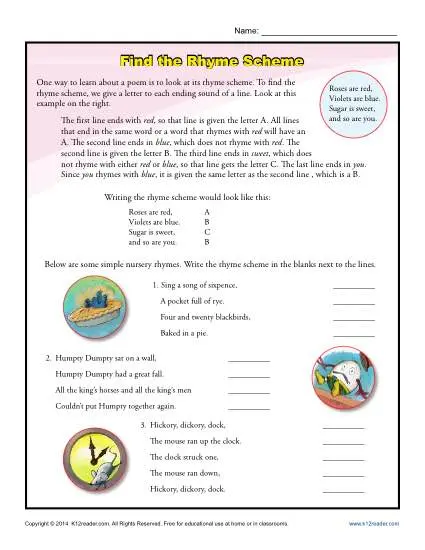

Rhyme Scheme: The Rhythmic Heart of Poetry
- The Albert Team
- Last Updated On: February 16, 2024
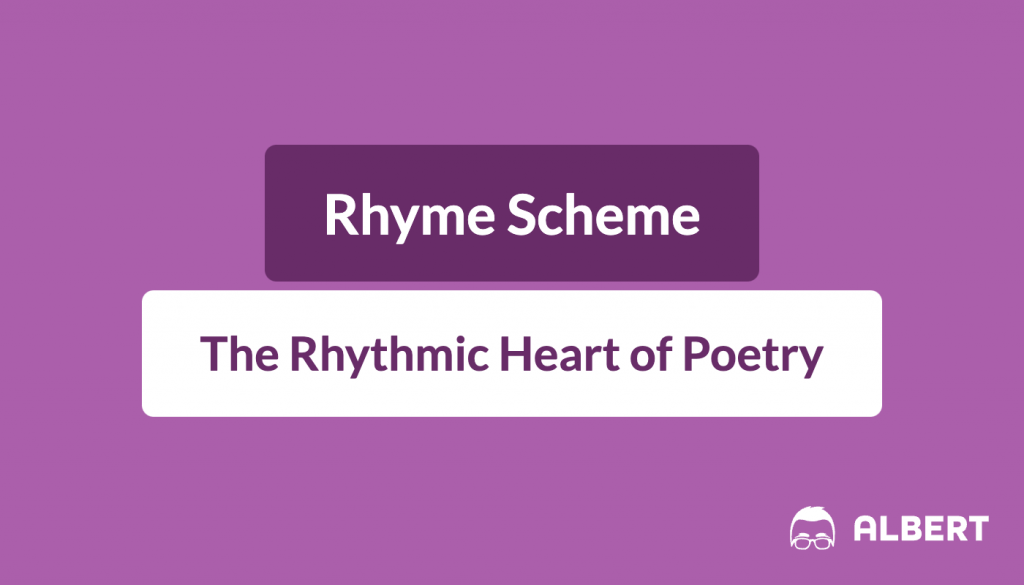
What We Review
Introduction to Rhyme Scheme in Poetry
The rhyme scheme definition is a deliberate structural pattern in poetry where the words at the end of individual lines within a poem stanza are intentionally rhymed with words at the end of other lines within the same stanza. Rhyme scheme is notated in poetry by using letters of the alphabet.
The first set of lines that rhyme with one another are notated with the letter “a”. The second set of lines that rhyme with one another and use a different rhyme are notated with the letter “b”. Edgar Allan Poe’s poem, “The Raven,” is a great rhyme scheme example. The rhyme scheme is ABCBBB:
“Once upon a midnight dreary, while I pondered, weak and weary, A Over many a quaint and curious volume of forgotten lore— B While I nodded, nearly napping, suddenly there came a tapping, A As of someone gently rapping, rapping at my chamber door. B “’Tis some visitor,” I muttered, “tapping at my chamber door— B Only this and nothing more.” B Poe, Edgar Allan. “The Raven.” Poetry Foundation , https://www.poetryfoundation.org/poems/48860/the-raven. Accessed 29 Jan. 2024.
The purpose of the rhyme scheme in a poem is to establish the tone and mood as well as emphasize the central message of the poem. In “The Raven” poem above, Poe maintains this rhyming pattern to signify “Lenore”, the narrator’s love who has died and whom the narrator is grieving. By continuing to end the second, fourth, fifth, and sixth lines of each stanza with words that rhyme with “Lenore”, Poe is emphasizing the all-encompassing grief that the narrator feels over the loss of a loved one.
Rhyme Scheme Examples: Exploring Patterns and Forms
There are many different types of rhyme schemes. For example, rhyming couplets consist of a pair of lines written sequentially that rhyme with one another. Shakespeare uses rhyming couplets often to end his love sonnets, such as Sonnet 18 :
“So long as men can breathe or eyes can see, So long lives this and this gives life to thee.”
There is also alternating rhyme (ABAB), enclosed rhyme (ABBA), triplet rhyme (AAA), monorhyme (AAAA), and villanelle (ABA).
In addition to these rhyming patterns for individual stanzas, there are specific poetry forms that build off of these rhyme scheme patterns. For example, a Shakespearean sonnet uses an alternating rhyme scheme for the first 12 lines and a rhyming couplet for the last two lines. On the other hand, a haiku, one of the shortest poetic forms at only three lines long, follows the villanelle rhyme scheme but also only allows a certain number of syllables per line, adding to its complexity. A limerick is yet another poetic form that is based loosely on the enclosed rhyme format with one additional line at the beginning (AABBA).
Each of these forms has a unique purpose in communicating a different message to the reader. In his sonnets, Shakespeare wanted to express his love through poetry by using highly figurative language, but he also believed strongly in forming a balanced and intricate poetic structure to enforce the complex nature of his love.
Rooted in Japanese history, the haiku is intended to mimic the emotional impact of brief moments of insight. Therefore, the poem relies on very few words within a strict poetic structure to capture the brevity of these moments. Whatever the structure of the poem, rhyme scheme plays a crucial role.
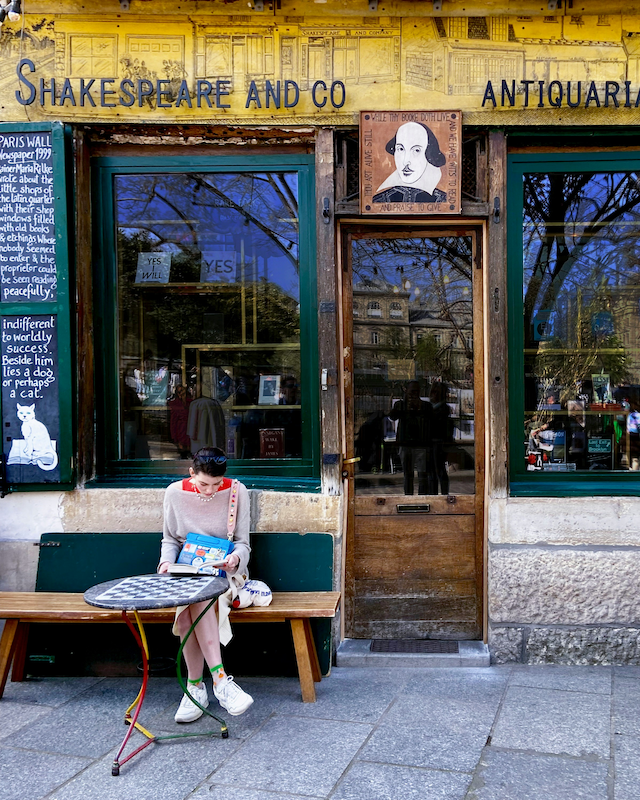
Sonnet Rhyme Schemes: A Case Study
As stated previously, William Shakespeare wrote over 100 sonnets, each one following a strict, alternating rhyme scheme for the first 12 lines and a rhyming couplet for the last two lines in order to mirror the complex and intricate nature of love. While Shakespeare’s sonnets are the most well-known of the sonnet forms, there are two more sonnet rhyme schemes: Petrarchan and Spenserian.
Petrarchan Sonnets
Petrarchan sonnet rhyme scheme follows a ABBAABBA; CDECDE or CDCDCD rhyme scheme. Spenserian sonnet rhyme scheme follows an ABAB, BCBC, CDCD, EE rhyme scheme. Petrarch was an Italian poet during the Italian Renaissance who wrote primarily about love being just out of reach. Sir Thomas Wyatt makes use of Petrarchan form and subject in his poem, “Whoso List to Hunt” :
“Whoso list to hunt, I know where is an hind, But as for me, hélas, I may no more. The vain travail hath wearied me so sore, I am of them that farthest cometh behind.” Wyatt, Sir Thomas. “Whoso List to Hunt.” Poetry Foundation. https://www.poetryfoundation.org/poems/45593/whoso-list-to-hunt-i-know-where-is-an-hind. Accessed 30 Jan.2024
In this poem, the rhyme scheme follows an ABBA format in the first stanza, meaning that the first and fourth lines rhyme with one another while the second and third lines rhyme with one another. The message of the poem follows the theme of love being just out of reach as a “hind” (or deer) is compared to a woman that the speaker is hunting. Chasing this deer (or woman) has exhausted him and he is ready to give up.
Spenserian Sonnet
The Spenserian sonnet is named after Edmund Spenser, a British poet during the Elizabethan period. Spenserian sonnets are also usually on the topic of love, as seen in Sonnet 75 :
“One day I wrote her name upon the strand, But came the waves and washed it away: Again I wrote it with a second hand, But came the tide, and made my pains his prey. “Vain man,” said she, “that dost in vain assay, A mortal thing so to immortalize; For I myself shall like to this decay, And eke my name be wiped out likewise.” Spenser, Edmund. “Amoretti LXXV: One Day I Wrote her Name.” Poetry Foundation. https://www.poetryfoundation.org/poems/45189/amoretti-lxxv-one-day-i-wrote-her-name. Accessed 14 Feb. 2024
In this poem, Spenser uses his own sonnet format of ABAB, which looks very similar to a Shakespearean sonnet; however, Spenser does not continue the second stanza with a CDCD rhyme scheme like Shakespeare would. Rather, the second stanza connects to the rhyme scheme of the first by following a BCBC rhyme scheme, continuing the rhyme from the second and fourth lines into the fifth and seventh lines. Spenser’s sonnet follows a similar theme as Shakespeare’s sonnets as the speaker claims that his love will not die as all humans do; rather she will live eternally through his sonnets.

The Nuances of Slant Rhyme in Poetic Rhythm
While exact rhymes are easy to spot (bat and rat), slant rhyme allows for similar sounding words to be paired with one another. Song writers do this all the time; for example, “My Shot” by Lin Manuel Miranda uses both exact rhymes and slant rhymes:
“I prob’ly shouldn’t brag, but dag, I amaze and astonish The problem is I got a lot of brains but no polish […] See, I never thought I’d live past twentyWhere I come from, some get half as many.”
Miranda uses exact rhyme by pairing the words “astonish” and “polish”, but he also uses slant rhyme by pairing the words “twenty” and “many”.
Meter in Poetry: Understanding its Role and Variations
What is meter in poetry? Meter in poetry provides the rhythm or the pulse of the poem. The definition of meter in poetry is the “pattern of beats in a line of poetry”. Meter is measured by “feet”, or stressed and unstressed syllables.
The five primary types of meter are iambs, trochees, spondees, anapests and dactyls. The meters with two-syllable feet are iambic, trochaic, and spondaic. The meters with three-syllable feet are anapests and dactyls. Shakespeare wrote all of his sonnets in iambic pentameter, which means that every line had five iambs, or ten syllables total.
Sonnet 116 provides an example of this:
“Let me not to the mar riage of true minds Ad mit im ped i ments ; love is not love Which al ters when it al ter a tion finds , Or bends with the re mov er to re move .” Shakespeare, William. Sonnet 116. Poetry Foundation. https://www.poetryfoundation.org/poems/45106/sonnet-116-let-me-not-to-the-marriage-of-true-minds. Accessed 14 Feb 2024.
Iambic pentameter always starts with an unstressed syllable and is followed by a stressed syllable. Above, the stressed syllables are notated in bold.
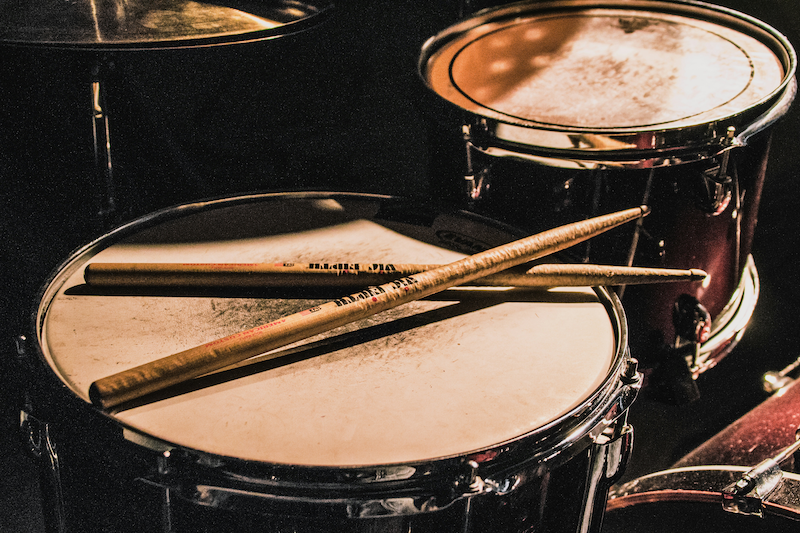
Consonance, Alliteration, Repetition, and Assonance: Sound Devices in Poetry
Sound devices in poetry also play an important role in establishing the tone, mood, and overall message of the poem. A few examples of sound devices in poetry are consonance, alliteration, repetition and assonance.
Consonance in Poetry
Consonance in poetry occurs when words with the same consonant sound are used together, whether in the same line, across multiple lines, or at the end of lines to coincide with the rhyme scheme. An example of consonance is in William Blake’s “The Chimney Sweeper” poem wherein he repeats the consonant “t”:
“And so he was quiet, & that very night, “And so he was quiet, & that very night, As Tom was a-sleeping he had such a sight!” Blake, William. “The Chimney Sweeper: When my mother died I was very young.” The Poetry Foundation. https://www.poetryfoundation.org/poems/43654/the-chimney-sweeper-when-my-mother-died-i-was-very-young. Accessed 14 Feb 2024.
Alliteration in Poetry
Alliteration in poetry occurs when words with the same first consonant letter are used sequentially in a line or several lines of poetry. An example of alliteration can be found in Emily Dickinson’s poem, “Behind me–dips Eternity” :
“Death but the Drift of Eastern Gray, Dissolving into Dawn away” Dickinson, Emily. “Behind me-dips Eternity.” All Poetry. https://allpoetry.com/Behind-Me–dips-Eternity. Accessed 14 Feb 2024.
Assonance in Poetry
Assonance in poetry occurs when words with the same vowel sounds are used together, whether in the same line, multiple lines, or and the end of lines. For example, “In a Garden” by Amy Lowell repeats the “i” sound throughout the first stanza.
“In granite-lipped basins, Where iris dabble their feet And rustle to a passing wind, The water fills the garden with its rushing, In the midst of the quiet of close-clipped lawns.” Lowell, Amy. “In a Garden.” Poetry Foundation , 1 Jan. 2002, https://www.poetryfoundation.org/poems/42983/in-a-garden-56d221a5bfad9. Accessed 30 Jan. 2024.
Repetition in Poetry
Finally, repetition in poetry is fairly self-explanatory, but it is the intentional repetition of words, phrases, lines, or entire stanzas in order to focus the reader’s attention. A couple of examples of repetition can be found in Dylan Thomas’ poem, “Do Not Go Gentle Into That Good Night” :
“Do not go gentle into that good night, Old age should burn and rave at close of day; Rage, rage against the dying of the light. Though wise men at their end know dark is right, Because their words had forked no lightning they Do not go gentle into that good night.” Thomas, Dylan. “Do Not Go Gentle Into That Good Night.” Poetry Foundation. https://www.poetryfoundation.org/poems/46569/do-not-go-gentle-into-that-good-night. Accessed 14 Feb. 2024
In this poem, Thomas not only repeats individual words (rage, rage), but he also repeats an entire line throughout the poem: “Do not go gentle into that good night”. This repetition serves both the tone and mood by emphasizing the serious tone of the speaker’s charge to his listeners as well as a dark and frightening mood.
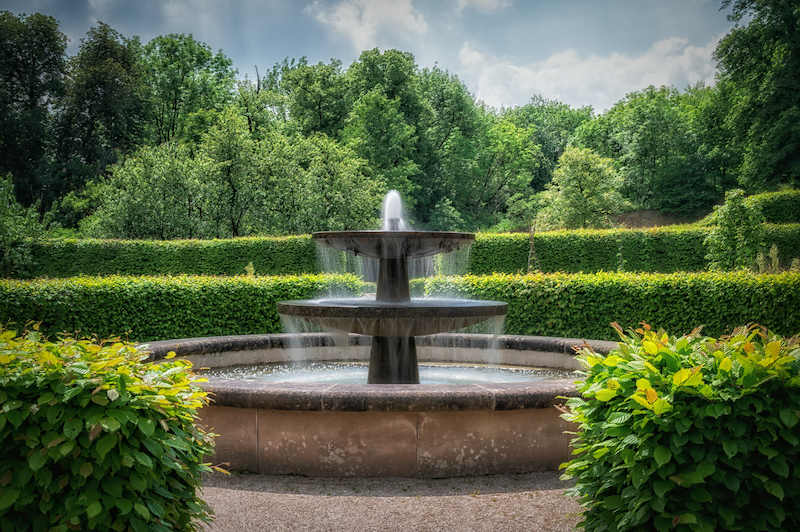
Analyzing Rhyme Schemes: Examples in Famous Poems
Now that you have background knowledge on how to identify a poem’s rhyme scheme, let’s put these skills together to analyze the rhyme scheme of Shakespeare’s Sonnet 18 .
“Shall I compare thee to a summer’s day? Thou art more lovely and more temperate: Rough winds do shake the darling buds of May, And summer’s lease hath all too short a date; Sometime too hot the eye of heaven shines, And often is his gold complexion dimm’d; And every fair from fair sometime declines, By chance or nature’s changing course untrimm’d; But thy eternal summer shall not fade, Nor lose possession of that fair thou ow’st; Nor shall death brag thou wander’st in his shade, When in eternal lines to time thou grow’st: So long as men can breathe or eyes can see, So long lives this, and this gives life to thee.” Shakespeare, William. “Sonnet 18: Shall I compare thee to a summer’s day?” Poetry Foundation. https://www.poetryfoundation.org/poems/45087/sonnet-18-shall-i-compare-thee-to-a-summers-day. Accessed 14 Feb. 2024.
1. First, look at the end of the first two lines. Do they rhyme with one another, or not? In this case, the first two lines do not rhyme with one another, so they will be notated with different letters. When labeling the rhyme scheme, remember that each line is designated with a different letter of the alphabet, so the first line will be notated with a capital “A”, and the second line will be notated with a capital “B”.
2. Next, you will look at the next two lines. Do either of them rhyme with lines 1 or 2? If they do, pretend like you are playing a matching game and pair each line with its rhyming partner. In this instance, line 3 rhymes with line 1, and line 2 rhymes with line 4. Therefore, the rhyme scheme of this poem so far is ABAB.
3. Continue working through the poem, two lines at a time, and don’t assume that a poem will continue the same pattern throughout. In this poem, the last two lines form a rhyming couplet and rhyme with one another instead of an odd or even number line.
Conclusion: The Synergy of Rhyme and Meter in Poetry
Poetic structure is far more complex than we sometimes give credit. From rhyme scheme to meter to the overall poetic structure or use of poetic devices, poetry is not something that can be written or read speedily without deep consideration. However, knowing how to recognize and implement different rhyme schemes, sound devices, or types of meter not only increases one’s ability as a writer, but it also leads to a deeper understanding when reading poetry and leads us to appreciating the time and skill of these poets across the centuries.
For more practice analyzing rhyme and meter in poems, check out Albert’s Poetry course!
Interested in a school license?
Popular posts.

AP® Score Calculators
Simulate how different MCQ and FRQ scores translate into AP® scores

AP® Review Guides
The ultimate review guides for AP® subjects to help you plan and structure your prep.

Core Subject Review Guides
Review the most important topics in Physics and Algebra 1 .

SAT® Score Calculator
See how scores on each section impacts your overall SAT® score

ACT® Score Calculator
See how scores on each section impacts your overall ACT® score

Grammar Review Hub
Comprehensive review of grammar skills

AP® Posters
Download updated posters summarizing the main topics and structure for each AP® exam.

Poetry Rhyming Schemes: Examples
Written by Dan
Last updated February 13, 2024
Do you love the sound of a good poem? The rhythms and rhymes woven together artfully like threads on canvas to create something beautiful, intricate, and meaningful.
If so, then believe us when we say that understanding poetry rhyming schemes is key to crafting verses that will captivate your audience.
This blog post is here to break down what exactly those know-it-all literary snobs mean by things like an ABAB scheme or imperfect rhyme scheme – don’t worry if it’s all sounding gibberish right now!
We’ll make sure you’re a master of poetry by the end of this post.
Related : For more, check out our page with 100s of Example Poems here.

Table of Contents
Common Poetry Rhyming Schemes:
- Alternate rhyme (ABAB) : This scheme means you alternate between end sounds. For example, “Shall I compare thee to a summer’s day? (A) / Thou art more lovely and more temperate (B) / Rough winds do shake the darling buds of May (A) / And summer’s lease hath all too short a date (B).
- Couplet (AA) : A couplet is a two-line stanza that rhymes. For example, “True wit is nature to advantage dressed / What oft was thought but ne’er so well expressed.”
- Enclosed rhyme (ABBA) : This pattern is where the first and last lines rhyme and the second and third lines rhyme. An example would be, “Looking as if she were alive, I call (A) / That piece a wonder, now… (B) / Hell in the Heavens and Heaven in Hell (B) / Is but a magic shadow-show (A).”
- Monorhyme (AAAA) : This is a poem or a stanza where every line has the same end rhyme. Here’s an example: “In Xanadu did Kubla Khan / A stately pleasure-dome decree / Where Alph, the sacred river, ran / Through caverns measureless to man.”
- Limerick (AABBA) : Limericks have a specific form of five lines where the first, second, and fifth lines rhyme, while the third and fourth lines form a rhymed couplet.
- Sonnet (ABABCDCDEFEFGG) : This is the rhyming scheme for a Shakespearean sonnet, with three quatrains (four lines each) and a final rhymed couplet.
- Terza rima (ABA BCB CDC, etc.) : This scheme uses tercets, three line stanzas. Dante Alighieri first used it in The Divine Comedy.
- Quatrain (ABBA or ABAB) : A quatrain is a stanza of four lines, usually with alternate rhymes.
Related : For more, check out our article on Poems Without Rhyme here.
Examples of Alternate Rhyme (ABAB)
- “Life is but a fleeting dream (A) To ponder as we stand (B) Along the river’s gentle stream, (A) Footprints in the sand.” (B)
- “The moon was shining sulkily, (A) Because she thought the sun (B) Had got no business to be there (A) After the day was done.” (B) – Lewis Carroll
- “The sky so deep and wonderfully blue, (A) Today there is no cloud in sight, (B) Reflects in the ocean’s hue, (A) In waves, with the morning light.” (B)
- “In the quiet of the night, (A) Stars twinkle with all their might, (B) Bathing the world in silver light, (A) A truly spectacular sight.” (B)
- “The gentle whisper of the breeze, (A) Converses with the trees, (B) It carries secrets of the seas, (A) And sets the soul at ease.” (B)
- “A garden filled with sweet delight, (A) Blooms dancing in the morning light. (B) Colours bold and fragrances bright, (A) A feast for the senses, day and night.” (B)
- “Through fields of gold and forests green, (A) Walked a girl, not yet a queen. (B) Her heart was pure, her spirit keen, (A) The fairest maiden ever seen.” (B)
- “Underneath the old oak tree, (A) That’s where you will find me, (B) Lost in a book, wild and free, (A) In the company of a bumblebee.” (B)
- “The night is dark, the stars are bright, (A) The moon is giving a lovely light. (B) Everything seems just right, (A) As we dance in the cool of the night.” (B)
- “In the heart of the city’s hum and roar, (A) I long for the ocean’s calming shore. (B) Where waves crash and seagulls soar, (A) That’s where my spirit begins to restore.” (B)

Examples of Couplet (AA)
- “In the heart of winter’s frost so deep, Still, nature’s beauty makes me weep.”
- “Underneath the azure sky so bright, Dances the sunlight, pure and light.”
- “In fields of gold where poppies sway, I lose myself, I drift away.”
- “The moon above in silent glory hangs, Listening to the nightingale’s sweet songs.”
- “Through the quiet forest, a river flows, Carrying secrets nobody knows.”
- “Beneath the stars, two lovers kiss, Lost in a moment of perfect bliss.”
- “The waves crash against the distant shore, A symphony I’ve come to adore.”
- “In the eyes of a child, wonders unfold, A world of stories yet to be told.”
- “In the stillness of the night, so serene, The world reveals what’s seldom seen.”
- “With every sunset, rich and grand, I’m reminded of life’s shifting sand.”
Examples of Enclosed Rhyme (ABBA)
- “In the quiet of the morning light, (A) The world awakes from the still of night, (B) From the east to the west, a beautiful sight, (B) Bathed in hues of soft sunlight.” (A)
- “Beneath the moon’s gentle glow, (A) The city sleeps in the valley below, (B) A peaceful scene, a tranquil tableau, (B) Under the blanket of snow.” (A)
- “The forest whispers tales of old, (A) Of brave hearts and spirits bold, (B) In every leaf, stories are told, (B) Secrets in the green and gold.” (A)
- “In the heart of the bustling city’s din, (A) There’s a hidden garden, tucked within, (B) A peaceful sanctuary, a haven of Zen, (B) Amidst the chaos, a place of serenity unseen.” (A)
- “The ocean sings a lullaby so sweet, (A) Where the sky and the water meet, (B) A melody that’s hard to beat, (B) A symphony in every retreat.” (A)
- “In the depth of winter’s icy hold, (A) The world is bathed in hues of cold, (B) Yet in the silence, beauty unfolds, (B) A spectacle to behold.” (A)
- “Beyond the hills, where the sun sets low, (A) Lies a land where the wildflowers grow, (B) Bathed in the evening’s golden glow, (B) A paradise only dreamers know.” (A)
- “The stars above, in the night sky so clear, (A) Twinkle with a light so dear, (B) Guiding the lost, far and near, (B) Whispering, ‘Have no fear.'” (A)
- “In the heart of the desert, under the blazing sun, (A) Life is harsh, and comforts are none, (B) Yet, beauty thrives, undone, (B) In the land forgotten by everyone.” (A)
- “Underneath the old willow tree, (A) The river flows to the sea, (B) Carrying stories, wild and free, (B) In its journey to eternity.” (A)
Examples of Monorhyme (AAAA)
- “In the heart of the forest green, A world of wonders yet unseen. A paradise, serene and clean, Nature’s masterpiece, a dream.”
- “Underneath the starlit sky, Where dreams take flight and spirits fly. In the silence, you and I, Lost in time, as moments go by.”
- “The river flows with gentle grace, Reflecting the sky’s vast open space. In its mirror-like surface, The world finds its place.”
- “In the quiet of the night so deep, While the world is lost in sleep. Secrets the moon does keep, In her luminous, silver sweep.”
- “Beneath the sun’s golden glow, Where the wildflowers grow. The wind whispers low, Secrets only the heart can know.”
- “In the heart of winter’s frost, Where warmth and light seem lost. Yet, life pays the cost, Awaiting spring’s soft frost.”
- “Underneath the old oak tree, There’s a world for us to see. A place where we can be, Wild and free, just you and me.”
- “The ocean, vast and wide, With its powerful, surging tide. Secrets in its depths reside, Stories in its waves confide.”
- “In the city’s bustling street, Where different lives meet. Each story unique and replete, Life’s symphony in every beat.”
- “The mountains stand tall and grand, Overlooking the sprawling land. Timeless, they withstand, Nature’s art, so beautifully planned.”
Examples of Limerick (AABBA)
- “There once was a man from Kent, (A) Whose body was terribly bent. (A) He walked with a lean, (B) And was rarely seen, (B) Without his back being slightly dent.” (A)
- “A curious cat in a hat, (A) Chased after a mischievous rat. (A) They ran round and round, (B) Neither to be found, (B) Until they both ran into a bat.” (A)
- “A young girl with a magical flute, (A) Played melodies that were absolute. (A) She charmed every bird, (B) With every note heard, (B) Even the owl gave a hoot.” (A)
- “There was an old man from Peru, (A) Who dreamt he was eating his shoe. (A) He woke up at night, (B) With a terrible fright, (B) And found it was perfectly true.” (A)
- “A painter who lived in Great Britain, (A) Improved on his sketches by sittin’. (A) His art was sublime, (B) His subjects, prime time, (B) The critics were utterly smitten.” (A)
- “There once was a boy named Drew, (A) Who wanted to sail to Timbuktu. (A) In a boat made of sheets, (B) And some old beat-up cleats, (B) He set off under skies of blue.” (A)
- “A baker from sunny Spain, (A) Loved to dance in the rain. (A) With a twist and a twirl, (B) He gave it a whirl, (B) And baked his bread without any pain.” (A)
- “There was a young lady named Rose, (A) Who could touch her toes with her nose. (A) With a stretch and a bend, (B) And a twist at the end, (B) She put on quite the show, I suppose.” (A)
- “A writer who lived in a tower, (A) Wrote a book every hour. (A) With ink and quill, (B) He wrote with skill, (B) Words bloomed like a flower.” (A)
- “A chef from the town of Bree, (A) Cooked a stew spicy as could be. (A) With a dash and a sprinkle, (B) And a taste that would tingle, (B) It was loved by all, from land to sea.” (A)
Examples of Sonnet (ABABCDCDEFEFGG)
- “Upon a hill, beneath the summer’s sun, (A) I saw a sight that made my heart take flight. (B) A field of flowers, gold and purple spun, (A) Bathed in the day’s warm, gentle light. (B) The butterflies danced in the soft breeze, (C) The bees buzzed, busy in their sweet affair, (D) The world felt at ease beneath the trees, (C) In this moment, free from care. (D) To capture this scene, in words or in art, (E) Is a task no mortal could complete. (F) For such beauty, can only impart, (E) Feelings that are silently sweet. (F) Yet, in this attempt, I find delight, (G) In nature’s embrace, everything feels right.” (G)
- “In the heart of the city’s bustling crowd, (A) Amidst the noise, loud and proud, (B) There’s a silence to be found, (A) A tranquility that’s profound. (B) In the rhythm of the street’s beat, (C) Where different lives meet, (D) Stories unfold, bittersweet, (C) In every alley and every concrete. (D) The city, with its towering height, (E) Shimmers in the moon’s silver light. (F) A sight that fills the night, (E) With a magic that feels right. (F) In this urban sprawl, I find my peace, (G) In its chaos, I find release.” (G)
Examples of Terza Rima (ABA BCB CDC, etc.)
- “Upon a hill beneath the summer sky, (A) Where wildflowers bloom with colors bright, (B) I watch as time just seems to fly. (A) Bright butterflies take their flight, (B) Dancing in the day’s warm light, (C) A sight that fills me with pure delight. (B) Light kisses from the sun so bright, (C) As the breeze whispers a lullaby, (D) Everything feels just right. (C)”
- “In the city’s heart where life is high, (A) Amidst the noise and the crowd’s sigh, (B) I find a peace that money can’t buy. (A) Sighs of the street under the sky, (B) Stories unfold, hellos and goodbye, (C) In the city’s rhythm, under the moon’s eye. (B) Goodbye to worries, under the moon’s lie, (C) The city sleeps in the night’s tie, (D) Bathed in starlight, under the celestial spy. (C)”
- “Beneath the old oak tree so high, (A) Where we used to dream and lie, (B) Memories flutter like a butterfly. (A) Lie here with me, under the sky, (B) Where our dreams can touch the sky, (C) And our spirits can truly fly. (B) Sky painted with hues of the sunset’s dye, (C) As the day whispers a soft goodbye, (D) In this moment, everything else is a lie. (C)”
Examples of Quatrain (ABBA or ABAB)
- “Upon a hill beneath the summer’s sun, (A) I watch as time just seems to run. (B) As wildflowers bloom, the day’s begun, (B) Underneath the sky, we are but one.” (A)
- “In the heart of the city’s bustling crowd, (A) Amidst the noise, loud and proud, (B) A silence profound, like a shroud, (B) In the rhythm of the street’s beat, I’m wowed.” (A)
- “Beneath the old oak tree so high, (A) Where we used to dream and lie, (B) Our spirits can truly fly, (B) Painted with hues of the sunset’s dye.” (A)
- “A field of flowers, gold and purple spun, (A) Bathed in the day’s warm, gentle light. (B) The world felt at ease beneath the sun, (A) In this moment, free from any fight.” (B)
- “The butterflies danced in the soft breeze, (A) The bees buzzed, busy in their sweet affair. (B) Such beauty, can only seize, (A) Feelings that are silently rare.” (B)
- “Upon a hill beneath the sky, (A) I saw a sight that made my heart take flight. (B) I watch as time just seems to fly, (B) Bathed in the day’s warm, gentle light.” (A)
- “In the rhythm of the street’s beat, (A) Where different lives meet, (B) Stories unfold, bittersweet, (B) In every alley and every concrete.” (A)
- “The city, with its towering height, (A) Shimmers in the moon’s silver light. (B) A sight that fills the night, (B) With a magic that feels right.” (A)
- “In this urban sprawl, I find my peace, (A) In its chaos, I find release. (B) Amidst the noise and the crowd’s lease, (B) I find a tranquility that will never cease.” (A)
- “Beneath the trees, the world felt at ease, (A) The bees buzzed, busy in their sweet affair. (B) To capture this scene, is a tease, (A) For such beauty, is beyond compare.” (B)
By now, you should understand what poetry rhyming schemes are and how they can be used to weave words into beautiful verses. Remember, these patterns, like ABAB, ABBA, or the imperfect rhyme scheme, are just tools to help you express your thoughts and feelings more effectively.
Don’t be afraid to experiment with them or even create your unique pattern. After all, poetry is about expressing individuality and creativity.
So pick up your pen, let your imagination run wild, and start crafting your captivating verses. Remember, in the world of poetry, there are no mistakes, only discoveries. Happy writing!
Related Posts
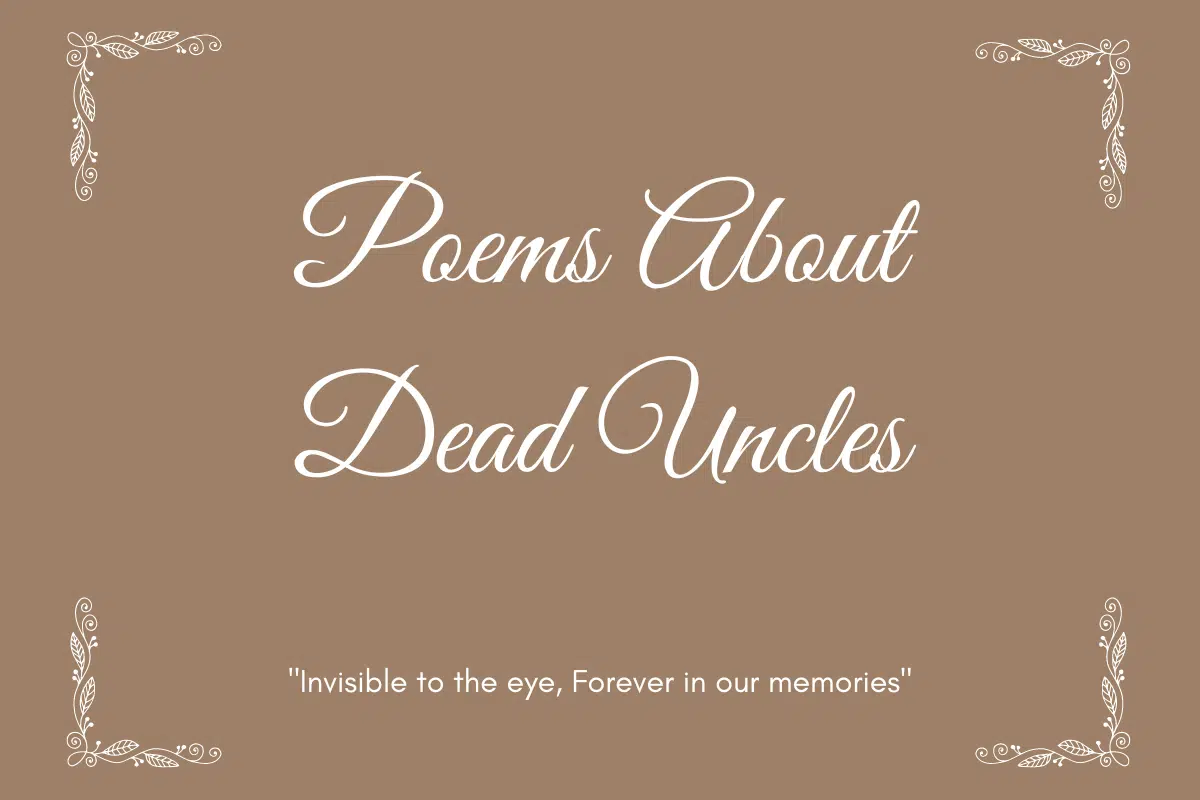
About The Author
I'm Dan Higgins, one of the faces behind The Teaching Couple. With 15 years in the education sector and a decade as a teacher, I've witnessed the highs and lows of school life. Over the years, my passion for supporting fellow teachers and making school more bearable has grown. The Teaching Couple is my platform to share strategies, tips, and insights from my journey. Together, we can shape a better school experience for all.

Join our email list to receive the latest updates.
Add your form here

Eight Poems to Teach Rhyme Scheme
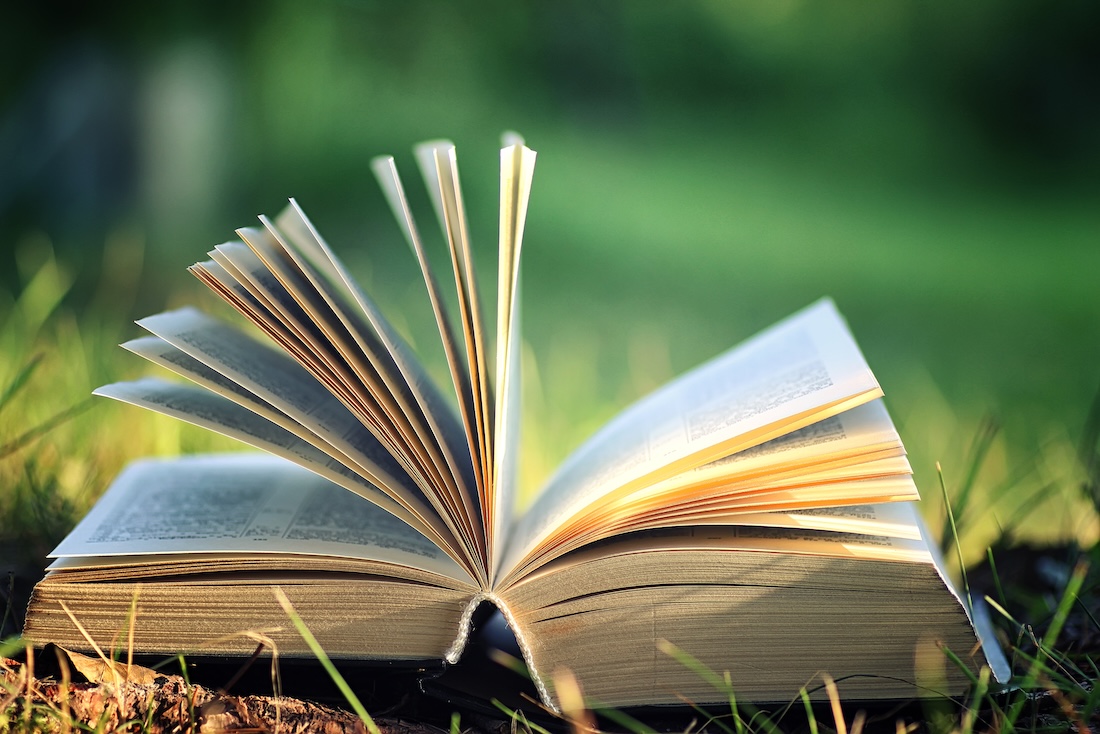
April is National Poetry Month, and there’s no better way to celebrate than by reading and learning about poetry! Last year, we developed a guide for learning figurative language through poetry , since metaphorical and abstract language thrives in the work of poets. Another important aspect of poetry is rhyme scheme, which helps writers develop rhythm and tone. Because understanding how to identify rhyme schemes and their purpose is a key ELA topic, we’ve developed this guide to finding rhymes and a collection of poems to teach rhyme scheme in hopes of aiding students in learning this important skill!
How to Find Rhyme Scheme in Poetry
A rhyme is created with sounds that repeat at the end of lines or phrases, and a rhyme scheme is a pattern of rhymes throughout a piece of writing. Rhyme is typically used to add rhythm and tone to a spoken-word work of writing, and it has been used for centuries in songs, chants, plays, poetry, and children’s stories. The easiest way to identify a rhyme scheme in anything is by reading it aloud!
Let’s use a famous nursery rhyme as an example:
“Humpty Dumpty sat on a wall , Humpty Dumpty had a great fall .
All the king’s horses and all the king’s men Couldn’t put Humpty together again .”
“Wall” and “fall” are rhyming words, so those two lines create a rhyme. “Men” and “again” also form a rhyme. Together, the two rhymes develop the rhyme scheme of “Humpty Dumpty”: AABB.
People describe rhyme schemes by assigning a letter of the alphabet to each unique sound at the end of a line or sentence. You keep track of the rhymes used in a poem by assigning “A” to the sound at the end of the first line, “B” to the next different sound, “C” to the third different end-of-line sound, and so on. When a sound is repeated, forming a rhyme, you repeat the letter assigned to that sound.
For example, ABAB means that the first and third lines in a stanza rhyme, and the second and fourth lines rhyme. ABCB means that the first and third lines don’t have a rhyme, while the second and fourth rhyme with one another.
Identifying Rhyme Scheme: Eye Rhymes and Near Rhymes
Finding rhyming schemes in poetry, plays, and songs can be easy, since you can often visually spot rhymes based on the similar spelling of two words (like “wall” and “fall”). Still, there are many exceptions.
Eye Rhymes: Looks Can Be Deceiving
Not all words that are spelled similarly rhyme. For example, “bear” and “fear” share an identical spelling after the first letter, but they are pronounced differently and don’t actually rhyme. These types of word pairs that “look” like they rhyme but actually don’t are eye rhymes / sight rhymes .
At the same time, there are many rhyming words that are spelled quite differently. “Men” and “again” (like in “Humpty Dumpty”) have very different spellings, but they form a rhyme. “Flair” and “bare” is another example.
Languages evolve and change over time, often resulting in the pronunciation of certain words changing. Many lines from older English poems used to rhyme but no longer do because of the evolution of the English language—these result in a type of eye rhyme called a historic rhyme . Consider this example from Shakespeare’s Hamlet :
“The great man down, you mark his favourite flies ;
The poor advanced makes friends of enemies .”
These lines follow an AA rhyme scheme, but the pair “flies” and “enemies” does not rhyme in today’s English. When Shakespeare wrote Hamlet around 1600, the two words rhymed in local dialects—it was a true rhyme that became an eye rhyme over time.
Near Rhymes: Close Enough!
In rhyming poetry and songs, you’ll often come across near rhymes / approximate rhymes —words that sound very similar but aren’t perfect rhymes. Some examples of near rhymes are “sauce” and “cost”, “orange” and “door hinge”, or “pecked” and “select”. Songwriters and poets often use near rhymes to get a particular idea across in cases where a true rhyme doesn’t exist.
“ How Do I Love Thee? ”, a sonnet by Elizabeth Barrett Browning, shows an example of near rhyme in poetry:
“How do I love thee? Let me count the ways .
I love thee to the depth and breadth and height
My soul can reach, when feeling out of sight
For the ends of Being and ideal of Grace .”
To make the ABBA rhyme scheme work, Browning develops an approximate rhyme of “ways” and “Grace”—the words don’t end with the same exact sound, but they’re close enough!
Common Rhyme Schemes in Poetry
While rhyming poems don’t have to follow a specific pattern, there are many common types of rhyming formats that writers use in their rhythmic work.
Simple Quatrain Rhyme Schemes
These rhyme scheme examples are the most common varieties you’ll see in poems and songs with four-line stanzas (also known as quatrains). Writers using this rhyme scheme can maintain the same rhymes throughout (Ex. ABAB ABAB… ) or change the rhymes in each stanza (Ex. ABAB CDCD… ), which is the more common approach.
1. Alternate Rhyme: ABAB
Alternate rhymes simply alternate a rhyme throughout—in each stanza, the first and third lines rhyme and the second and fourth lines rhyme.
“Far or forgot to me is near;
Shadow and sunlight are the same;
The vanished gods to me appear;
And one to me are shame and fame.”
(Ralph Waldo Emerson, “ Brahma ”)
2. Enclosed Rhyme: ABBA
In an enclosed rhyme stanza, the first and fourth lines rhyme and the second and third lines rhyme. Also referred to as an internal rhyme scheme, the A rhyme “sandwiches” the B rhyme in this format.
3. Simple Four-Line Rhyme: ABCB
A straightforward rhyme scheme in which only the second and fourth lines of a stanza rhyme, the simple four-line rhyme scheme is also called a ballad stanza. Poems using this rhyme scheme typically continue the pattern throughout, sometimes using repetition instead of rhyme.
“Day after day, day after day,
We stuck, nor breath nor motion;
As idle as a painted ship
Upon a painted ocean.”
(Samuel Taylor Coleridge, “ The Rime of the Ancient Mariner ”)
4. Monorhyme: AAAA
If you’re familiar with the Greek prefix “mono” meaning “one”, you understand that a monorhyme is a rhyme scheme in which the same rhyme is repeated. Writers can use the same rhyme throughout a stanza and switch to a different rhyme sound for the next stanza (Ex. AAAA, BBBB… ), or they can continue the same rhyme sound throughout the whole piece.
Note: A monorhyme formatted into different two-line stanzas is called a rhyming couplet : AA, BB, CC, DD. Rhyming couplets (or “coupled rhymes”) can make up an entire poem, or they can be integrated into a poem alongside a different rhyme scheme.
Fixed Verse Rhyme Schemes
Poems with rhyme schemes can follow more complex patterns of rhymes instead of repeating a four-line rhyme scheme like the ones above. These longer rhyme schemes are designated formats that poets have utilized in their work for hundreds of years.
The ballade is generally made up of three eight-line stanzas that follow an ABABBCBC rhyme scheme before a final, four-line stanza with a BCBC rhyme scheme. It is often used to convey a very formal, solemn tone.
Note: Don’t confuse the ballade with the ballad , which is a very long narrative poem made up of many four-line stanzas (which are usually the simple four-line rhyme—ABCB).
The sonnet is a widely-used 14-line form of poetry with distinct variants. The Petrarchan sonnet is three stanzas, the first two of which follow an identical enclosed rhyme scheme (ABBA ABBA CDECDE/CDCDCD) , while the Shakespearean (or “English”) sonnet is composed of three quatrains and one couplet that functions as a twist (ABAB CDCD EFEF GG) .
3. Villanelle
Also known as a villanesque, the villanelle is made up of nineteen lines—five tercets (three-line stanzas) followed by a quatrain. This form of poetry has a rigid rhyme scheme: each tercet follows an ABA rhyme scheme, while the quatrain follows the pattern ABAA . The villanelle also involves refrains—the first line of the poem must also be the sixth, twelfth, and eighteenth lines, while the third line of the poem must repeat for the ninth, fifteenth, and nineteenth lines.
4. Limerick
A tone shift from the more serious styles above, a limerick is a form of poetry popular in children’s rhymes and stories. While it also has rules when it comes to meter (the syllabic structure of a line) and internal rhyme (rhyme within a single line of poetry, rather than only at the end of a line), its simpler rhyme scheme combines the rhyming couplet with an enclosed rhyme: AABBA .
Now that you’re equipped with a baseline understanding of how to find rhyming scheme and some of the different formats used in rhyming poetry, let’s dive into some amazing poems to teach rhyme scheme .
From lesser-known works of acclaimed poets to famous poems known around the world, these works are fantastic tools to practice finding rhyme schemes, identifying common fixed verse rhyme schemes, and even analyzing the effect that rhyme has on a poem’s meaning and tone.
“Auguries of Innocence” by William Blake
Considered a nonconformist and visionary of the English Romanticism movement, William Blake (1757–1827) wrote about a wide range of topics including political criticism, the strength of the human spirit, spirituality, and nature. In “ Auguries of Innocence ”, Blake grapples with the good and evil present in everyday life, drawing attention to symbols of purity and innocence by contrasting them against negative, more malicious or “sinful” ideas.
This poem is not split into stanzas, as it is one long “paragraph” of consecutive lines. The rhyme scheme shifts from one pattern to another towards the beginning, and while the bulk of the poem seems like rhyming couplets, keeping track of all the rhymes may reveal that Blake involved a more consistent approach than you may think at first glance.
“The Catterpiller on the Leaf
Repeats to thee thy Mothers grief
Kill not the Moth nor Butterfly
For the Last Judgment draweth nigh”
(Lines 37–40)
“Do Not Go Gentle into That Good Night” by Dylan Thomas
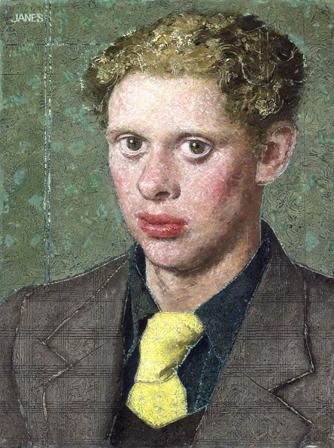
1934 painting of Dylan Thomas by Alfred Janes.
Dylan Thomas (1914–1953) is another exceptionally original poet, known for his innovative lyricism and imagery. While he didn’t align with any one group or movement of modern poetry, his work drew upon ideas from the romantic movement, surrealism, and even folklore. Often, it focused on topics like unity within diversity and the cyclical nature of life.
“ Do Not Go Gentle into That Good Night ” is a famous modern villanelle about how one should fight for life even when death is impending and inevitable. Referenced and recited in dozens of modern novels and films, analyzing the fixed verse together with its subject matter and figurative language can reveal how Thomas achieved the emotional depth in this poem.
“Do not go gentle into that good night,
Old age should burn and rave at close of day;
Rage, rage against the dying of the light.”
(Lines 1-3)
“Banking Coal” by Jean Toomer
The poetry of Jean Toomer (1894–1967) lyricizes the early 20th century experience of Black Americans and champions racial unity with an inspirational, uplifting tone. Though he is commonly associated with the Harlem Renaissance and the modernist movement, he rejected all such associations—as a mixed individual, he also resisted being labeled as “Black” or “white”.
“ Banking Coal ” speaks to the power of a single individual—how one person taking action can spark a massive change. It belongs in this collection of poems to teach rhyme scheme because of the way Toomer involves alternate rhymes and rhyming couplets at different points, developing a unique rhyme scheme that doesn’t fit neatly into one pattern. As you read, consider the detailed imagery together with the repeated rhymes and words throughout the poem.
“Whoever it was who brought the first wood and coal
To start the Fire, did his part well;
Not all wood takes to fire from a match,
Nor coal from wood before it’s burned to charcoal.”
(Lines 1–4)
“The Soul has Bandaged moments- (360)” by Emily Dickinson
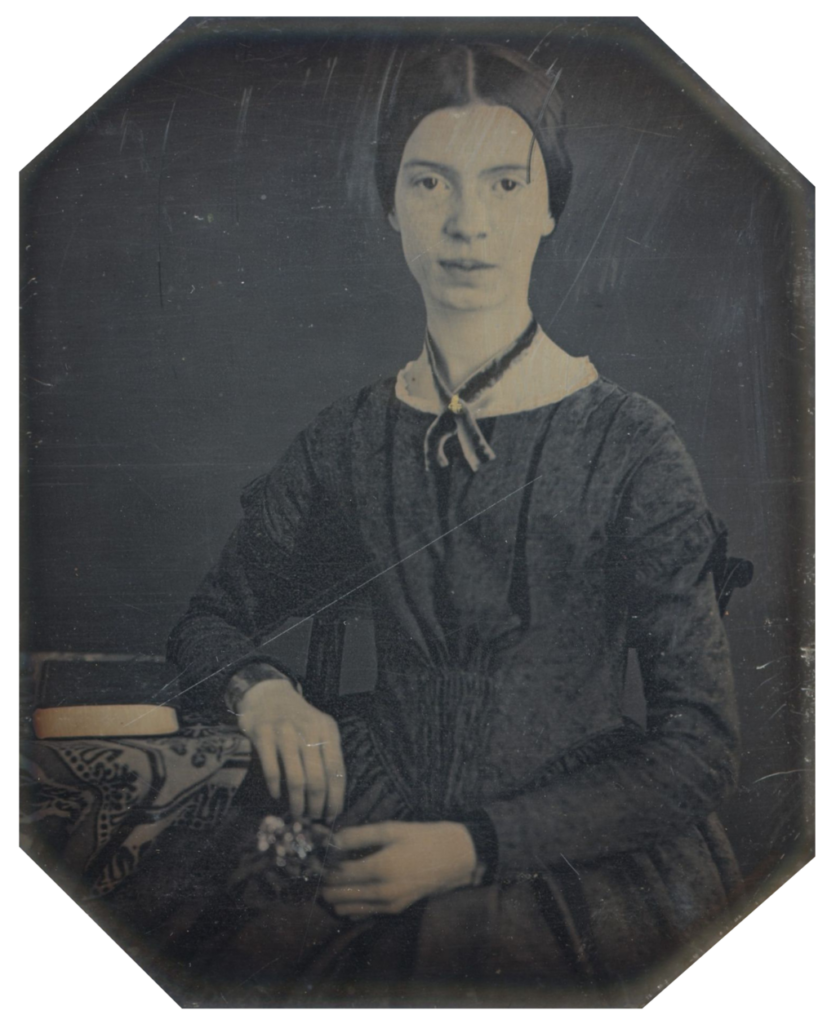
Emily Dickinson, 1846/1847.
Emily Dickenson (1830–1886) is one of the most celebrated American poets of all time. Looking through her vast collection of poetry reveals that she had a particular penchant for rhyming—most, if not all, of her works rhyme, so she is a must-read when it comes to learning about rhyme schemes.
“ The Soul has Bandaged moments ” is not very different from her other poems, both in terms of its subject matter and its rhyming structure. Dickinson frequently wrote about topics like death, immortality, and the human soul (the focus of this poem), most of her poetry includes an alternate rhyme scheme, and she was never afraid of using near rhymes on her quest to get her ideas across. Looking into the rhyme scheme of this poem in particular shows a shift away from the expected pattern. Those who take a closer look can see the internal rhymes Dickinson imbues into the poem (pay attention to “Bomb” and “opon” in the last two lines).
“The soul has moments of escape –
When bursting all the doors –
She dances like a Bomb, abroad,
And swings opon the Hours,”
(Lines 11-14)
“Tamerlane” by Edgar Allan Poe
Known for his spooky stories and emotional poems, Edgar Allan Poe (1809–1849) had a massive impact on American literature. His tales (like “The Raven”) are regarded as the vanguard of detective stories and horror fiction. Throughout his work, he’s known for masterfully using both rhetorical devices and rich figurative language to develop a frightening ambiance.
“ Tamerlane ” is about the relationship between independence and grief in a person—Poe writes from a fictionalized perspective of Timur, the conqueror that founded the Timurid Empire in the 14th century in Central Asia. For this speech to the speaker’s father, Poe weaves an intricate web of rhyme that follows no established fixed verse. Think: how do the rhymes help Poe convey the particular tone he is developing?
“Know thou the secret of a spirit
Bow’d from its wild pride into shame.
O! yearning heart! I did inherit
Thy withering portion with the fame,
The searing glory which hath shone
Amid the jewels of my throne,
Halo of Hell! and with a pain…”
(Lines 13-19)
“The Wild Swans at Coole” by William Butler Yeats
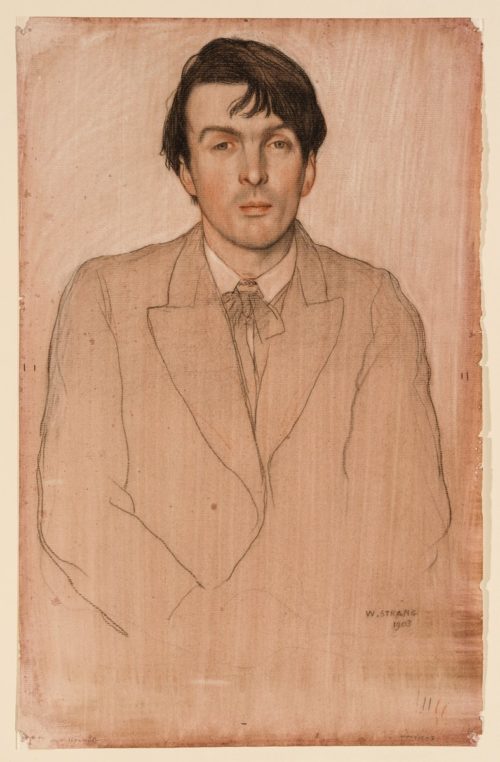
1903 drawing of William Butler Yeats by William Strang.
Irish poet William Butler Yeats (1856–1939) was a powerful force in 20th-century literature—as a Symbolist poet, he frequently used symbolic imagery and structures throughout his poetry. Although he is often remembered as one of the first Modernist poets, his early poetry is full of more traditional, Romantic forms, including rhyme schemes.
“ The Wild Swans at Coole ” is a magnificent nature poem about the tranquility of an Autumn lakeside scene. In it, Yeats uses precise imagery to paint a landscape of a lake in which fifty-nine swans are drifting. This combined with the unique rhyme scheme grants the poem an emotional tone that touches the reader’s heart.
“The trees are in their autumn beauty,
The woodland paths are dry,
Under the October twilight the water
Mirrors a still sky;”
(Lines 1-4)
“Phenomenal Woman” by Maya Angelou
An unparalleled poet, novelist, and civil rights activist, Maya Angelou (1928–2014) has received dozens of awards for her writing. Her poetry is understudied by literary critics (especially in comparison to her prose), but it’s widely popular—she’s been described as “the black woman’s poet laureate”, demonstrating how her poetry speaks to everyday people.
A ballad of female self-empowerment, “ Phenomenal Woman ” is one of Angelou’s most popular poems. She crafts an argument that embracing one’s uniqueness, especially as a Black woman, inspires the growth of powerful self-confidence. Angelou develops these strong ideas through the use of repetition and figurative language, but her implementation of rhyme takes it to the next level. Students should consider the rhyme scheme she chose and how it complements the structure of the poem as a whole.
“It’s in the reach of my arms,
The span of my hips,
The stride of my step,
The curl of my lips.
I’m a woman
Phenomenally.”
(Lines 5-11)
“The Runaway” by Robert Frost
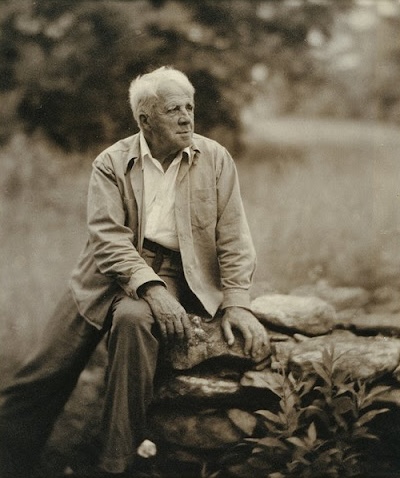
1955 photograph of Robert Frost by Clara Sipprell.
Robert Frost (1874–1963) was known for writing rhyming poetry that realistically depicted life in rural New England. He symbolically utilized nature poetry to convey themes of life and society, combining colloquial speech with traditional poetic forms. You may know him for “The Road Not Taken”, a poem about diverging paths in life symbolized by a fork in a forest road.
Similarly, “ The Runaway ” uses natural themes to convey Frost’s ideas about life and humanity. The poem is a short story about finding a frightened and lost young horse by a mountain pasture in winter. This tale conveys the innocence that all young living beings have, whether they are human children or young animals. Frost’s rhyme scheme swaps between dual rhymes and alternate rhymes—keep track of the rhymes and think about why he decided to shift the sounds when he did.
“‘I think the little fellow’s afraid of the snow.
He isn’t winter-broken. It isn’t play
With the little fellow at all. He’s running away.”
(Lines 9-11)
Improve Reading and Writing Skills with Piqosity
We hope this collection of poems to teach rhyme scheme was both informative and entertaining! Celebrating national poetry month by reading and learning about rhyme is a wonderful way to exercise ELA skills while enjoying the rhythm and songlike quality of poems.
If you’re struggling with concepts like figurative language or looking for ways to improve your English skills, Piqosity’s here to help! Along with our Digital SAT and ACT test prep courses, we also offer full online English courses —each includes dozens of concept lessons, personalized practice software, and over 100 reading comprehension passages.
- 5th Grade English Course
- 6th Grade English Course
- 7th Grade English Course
- 8th Grade English Course
- 9th Grade English Course
- 10th Grade English Course (new!)
- 11th Grade English Course
The best part? Try out all of Piqosity’s features with our free community account, which feature a free mini diagnostic exam to evaluate your current ELA skills. When you’re ready to upgrade, Piqosity’s year-long accounts start at only $89. Plus, get a 10% off coupon just by signing up for our mailing list !
More Educational Resources by Piqosity:
- Masterfully Written Poems to Teach Figurative Language
- Six Speeches to Teach Rhetorical Devices
- 12 Poems by Black Poets and Writers
- Books to Increase Vocabulary for Each Grade Level
- Books that Inspire STEM Students to Read
Share This Story, Choose Your Platform!
About the author: sara fetahagic.

Leave A Comment Cancel reply
Save my name, email, and website in this browser for the next time I comment.
ISEE, ACT, SAT, PSAT English 5 English 6 English 7 English 8 English 9 English 10 English 11 Math 5 Math 6 Pre-Algebra Algebra I Geometry Algebra II Pre-Calculus
Publications
Blog ISEE Prep Guide How to Teach the ISEE
ACT Answer Explanations ACT Strategies
Piqosity is neither affiliated with nor endorsed by ACTⓇ, SATⓇ, ISEEⓇ, SSATⓇ, or any other standardized test publisher.
Knowledge Base Submit a Ticket Known Issues & Release Notes
© 2024 Piqosity Corporation 2429 Bartlett St., Houston, TX 77098 +1-888-484-3141
About Us Acknowledgements Terms of Use Privacy Policy

Jack Prelutsky
- Homework! Oh, Homework!
Write your comment about Homework! Oh, Homework! poem by Jack Prelutsky
- Be Glad Your Nose Is On Your Face
- Deep In Our Refrigerator
- Bleezer's Ice Cream
- The Visitor
Recent Interactions*
- Wonderful Women by Umaru Kanneh Boima
- Freedom To Scratch In Peace by Olute Aete
- Happy New Year by Felix Menda
- Human Beings by Dana Graslie
- Lust by Wisdom Greatness
- An Isolated Tree's Song by Sayeed Abubakar
- A Strange Boy by Sayeed Abubakar
- O Soil by Sayeed Abubakar
- No War, No War-monger by Sayeed Abubakar
- Night's Town by Sayeed Abubakar
Popular Poets
- 1. Emily Dickinson (2414 poems)
- 2. Madison Julius Cawein (1231 poems)
- 3. Ella Wheeler Wilcox (1136 poems)
- 4. William Wordsworth (1016 poems)
- 5. Robert Burns (986 poems)
- 6. Edgar Albert Guest (945 poems)
- 7. Thomas Moore (849 poems)
- 8. Robert Service (831 poems)
Loving. Healing. Touching.
FFP Poetry Forums
- Forgot Your Password
- Login with Google
- Login with Facebook
- Popular Collections
ABCB Rhyme Scheme
Published: August 2017
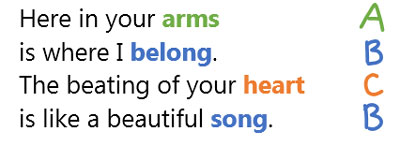
30 Poems With ABCB Rhyme Scheme: Definition And Examples
- By Langston Hughes
Famous Poem
Langston Hughes was an American poet who became famous for his work during the Harlem Renaissance. He was the first African American to support himself as a writer. In this poem, Langston Hughes shares the importance of having dreams. Without dreams, our lives do not feel complete. We do not have anything to work toward, so holding onto the dreams strengthens and empowers us. In this short poem, he pulls the reader’s attention to this theme by using the repetition of the phrase, “Hold fast to dreams.” Dreams is written in Quatrains (4 line stanzas) and follows the ABCB rhyme scheme.
in Famous Inspirational Poems
Hold fast to dreams For if dreams die Life is a broken-winged bird That cannot fly.
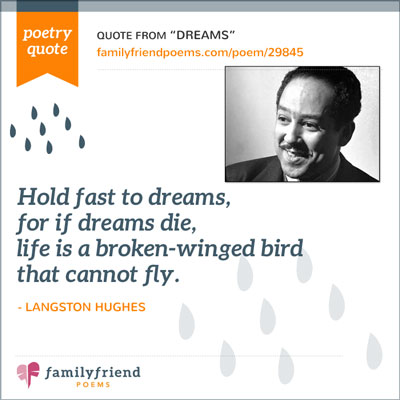
Go To Complete Poem
I so get it. Dreams are hope to a lot of us. I've heard it said that before you get it you have to dream it. I think when we stop dreaming we stop reaching, and when we stop reaching we stop...
Read complete story
Touched by the poem? Share your story! (3)
Life Is Fine
In this poem, the speaker is considering giving up on life, but he can’t go through with it. he finds that since he hasn’t died, he has something to live for. this poem has a strong sense of structure. it’s made up of single lines and quatrains with the abcb rhyme scheme..
in Famous Poems
I went down to the river, I set down on the bank. I tried to think but couldn't, So I jumped in and sank.
Everyone is born for a purpose, but we forget that in pursuit of money. Then God gifted me with poetry and uses it as a medium to educate people, and in each of my poems there is a story...
Touched by the poem? Share your story! (1)
Advertisement
Christmas Carol
- By Sara Teasdale
Sara Teasdale recounts the birth of Jesus and all who came to visit him. Some were wealthy, while others were poor. Some resided on Earth, while others came from heaven. All came to celebrate the birth of Jesus. Sara Teasdale was an American poet born in Missouri on August 8, 1884. She had six collections of poetry published during her lifetime and one published posthumously.
in Famous Holiday Poems
The kings they came from out the south, All dressed in ermine fine; They bore Him gold and chrysoprase, And gifts of precious wine.
No Stories yet, You can be the first!
Touched by the poem? Share your story! (0)
Love's Coming
- By Ella Wheeler Wilcox
Ella Wheeler Wilcox was an American author and poet who lived from 1850-1919. Her goal was to write pieces that lifted people’s spirits. In this poem, she writes of the great expectation of falling in love--that it will be an earth shattering moment, but the girl she writes about finds that she has fallen in love with someone who has always been by her side and is considered a close friend. That love has stood the test of time. This poem is made up of quatrains, four-line stanzas, that have a rhyme scheme of ABCB. The structure is also very intentional. The first two lines of each stanza show what the speaker hopes for when it comes to love, and the second two lines of each stanza reveal her reality.
in Famous Love Poems
She had looked for his coming as warriors come, With the clash of arms and the bugle's call; But he came instead with a stealthy tread, Which she did not hear at all.
I had an old book of EWW poems when I was young that had belonged to my Grandmother, who was born in 1904, given to her by my Grandfather. Reading them brings back some memories. I didn't...
Hope Is The Thing With Feathers
- By Emily Dickinson
Emily Dickinson, born in 1830 in Amherst, Massachusetts, is the author of almost 2,000 poems. Only after she died in 1886 were her poems discovered. In this metaphorical poem the bird is a symbol for hope. Hope Is The Thing With Feathers is written in quatrains and uses an ABCB rhyme scheme
"Hope" is the thing with feathers - That perches in the soul - And sings the tune without the words - And never stops - at all -
I recited this poem in grade six and it has been an inspiration for me ever since. Wonderful work!
The Fisherman
- By Abbie Farwell Brown
Abbie Farwell Brown was an American author who lived from 1871-1927. She lived in the same house her entire life, experiencing many traditions in her New England community. Brown describes the life of a fisherman in this poem, showing how one's profession becomes such a large part of a person's life. The Rhyme Scheme is ABCB.
in Famous Children Poems
The fisherman goes out at dawn When every one's abed, And from the bottom of the sea Draws up his daily bread.
The way the poet described the life of a fisherman, his continuous effort and sacrifice to stand independent, and the powerful simile used, makes the poem a classic one.
Will You Ever?
- By Kaitlyn M. Yawn
- Published by Family Friend Poems July 2006 with permission of the Author.
This poem is about the great impact that friends can have on each other's lives.
in Special Friend Poems
I don't think you will Ever fully understand How you've touched my life And made me who I am.

This poem brought tears to my eyes and joy to my heart. It said everything I wanted to say but never knew how to put it in words. It showed so much love and gratitude and much more. Continue...
Touched by the poem? Share your story! (20)
- By Eric Pribyl
- Published by Family Friend Poems February 2010 with permission of the Author.
I'm in love with a girl, but she doesn't see it, and I want her to, so I wrote this.
in Poems for Her
Analysis of Form and Technique
Amazing and beautiful, not a flower or a tree. Much prettier than that, and only I can see.
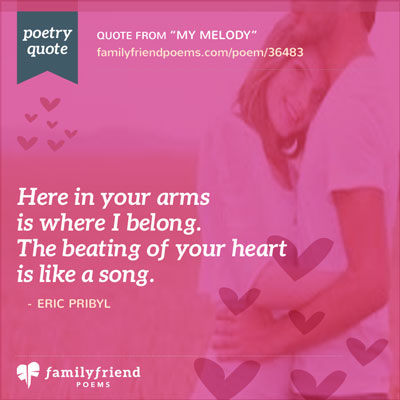
Beautiful poem. I love it. One of my favorite poems from Familyfriendspoems.com .
Touched by the poem? Share your story! (15)
Bonds Of Friendship
- By Craig Burkholder
- Published by Family Friend Poems January 2014 with permission of the Author.
This poem was written for a very special childhood friend that I reconnected with after many years. I was experiencing turmoil from a tragic personal situation, and she was suddenly reintroduced into my life. She is an amazing listener and friend, and I'll love her always. Thank you, Dawn.
From the day that I first knew you, Your heart was pure and kind; Your smile was sweet and innocent, Your wit was well refined.
By reading this poem, I was reminded of a time in the past when time and circumstances created a situation where we had to move away from all of the wonderful friends I had made and back to...
Touched by the poem? Share your story! (7)
When I'm With You
- By Blakelee
- Published by Family Friend Poems January 2008 with permission of the Author.
This poem is about how I felt when I was with my love.
in True Love Poems
In your arms, I'm in my safe haven. With you holding me tight, I have no other craving.

For the first time in this one life, I came to know that loving someone and getting back the love in return can make your life brighter than moonlight. I see you everywhere, though you are...
Touched by the poem? Share your story! (11)
Words Are Not Enough
- By Denese H. Boyett
- Published by Family Friend Poems August 2006 with permission of the Author.
in Romantic Poems
No words could ever tell you, No action could express The way I feel about you. With you, my life is blessed.
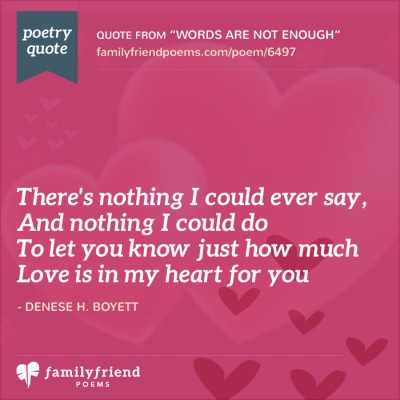
Love is deeper than we think. It sounds easy but binds a lot together. That’s why when finding someone to love, we must make sure we get it from a perfect source, and that source is God. Love...
Touched by the poem? Share your story! (6)
God's Gift To Me
- By Kerry R. DeVore
Two souls are bound in appreciation and love for one another.
in Sweet Love Poems
You are my sunshine. You are my shining star. Everything I'm not, You are.
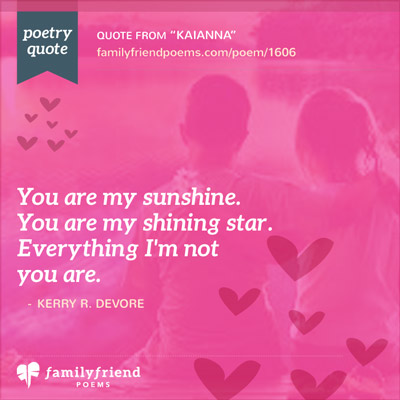
The poem conveys the intensity of feelings in a sweet and calm manner. That's the beauty of conveyor. The poem delights the reader's heart. I, myself, feel on cloud nine after reading this...
Touched by the poem? Share your story! (4)
Nobody Knows
- By Azumi Zaima
- Published by Family Friend Poems May 2016 with permission of the Author.
Being left by our love is painful, but what is more painful? Leaving your love knowingly and seeing him fight for you. That's the most painful. She knows it's her mistake. She knows she is giving him pain. She knows she can change it all but still can't and won't. She knows how empty she is without him. She loves him, but she can't express it. She has no one to express it to but her diary...
in Hurting Poems
Nobody knows it's empty, The smile that I wear. The real one is left behind in the past Because I left you there...
My girls left me for their dad and his wife. They felt they had to or they’d lose him. Kids are resilient? They just push it all down. It still wounds them. Who would think it would only...
Touched by the poem? Share your story! (29)
I Wish I Weren't Alone
- Published by Family Friend Poems June 2011 with permission of the Author.
Loneliness...it can destroy people. People pass you in the street and won't look twice. This poem is for those who have ever or do feel alone inside.
in Alone Poems
Once when I was little, I was happy and carefree. I used to run around laughing Until it was time for tea.
I was bullied at school because I was an ugly kid. Mum and Dad loved me for what I was. I had a failed marriage due to domestic violence and verbal abuse at me. I was locked up for defending...
Touched by the poem? Share your story! (25)
I Tried So Hard
- By Whitney Barton
- Published by Family Friend Poems December 2009 with permission of the Author.
I wrote this March 29, 2009. I was in a good relationship and nothing was wrong at the time, but the poem just kind of struck me. I liked the idea, so I wrote it out. Now I am no longer with this guy and am now in a relationship with a guy from my school, and we are doing very well.
in Heartbreak Poems
I tried so hard. I tried my best. I gave you my all, And now there's nothing left.
He was my first love We started dating while I was in high school. He was at university. We were so much in love, promising each other that we would be together forever. He taught me how to...
Touched by the poem? Share your story! (46)
Take Me Back
- Published by Family Friend Poems March 2008 with permission of the Author.
Sometimes when we end a relationship, we wish we hadn't...
in I'm Sorry Love Poems
How could I be so stupid To let you slip away? I had you in my arms, But I let you slip away.
This poem is really sad. I dated this boy. I’m not going to say that I didn’t love him because I truly did with all my heart, but everything was in a text. We never talked, and it made me...
Touched by the poem? Share your story! (31)
If I Could Tell You
- Published by Family Friend Poems July 2009 with permission of the Author.
I love this guy, but he doesn't know about my feelings. He is one of my best guy friends.
in Just Friends Poems
When I see you in the morning, it brightens up my day. There are so many thoughts on my mind, so many words I want to say.
When I met my guy best friend there was something about him. The way he talked to me. The way he smiled. The way he walked. I fell in love with him. On Homecoming, we went to the dance...
Touched by the poem? Share your story! (75)
You Are My Sunshine
- By Donna Donathan
- Published by Family Friend Poems May 2008 with permission of the Author.
I wrote this 28 years ago for someone very special in my life...
You brought me sunshine when I only saw rain. You brought me laughter when I only felt pain.
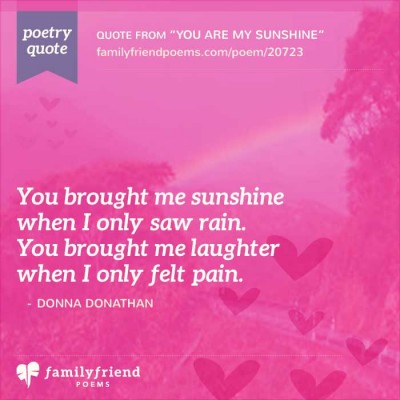
From the first time I looked into your eyes, I knew I loved you. Stunned by the warmth of your smile and hooked by your unconditional love, you have made me feel life like no other before....
- By Bryce Jennings
- Published by Family Friend Poems December 2007 with permission of the Author.
I wrote this to my girlfriend. It's easy when you have such a great muse.
It's that look in your eye. It's the smile on your face That makes time slip by, And I know I'm in a better place.
This is a great poem. I hope you write more!
Growing Up With Grandma
- By Candy Canan
- Published by Family Friend Poems May 2006 with permission of the Author.
The one who raises us is truly our parent, even if they did not give birth to us. November 6, 2004
in Grandmother Poems
I don't know when it happened. I don't know when she came, But she's the one I always knew. Grandma was her name.
This a was beautifully written piece. It "touched me" as the question asked. It also made me think about what my Grandma has been doing for me. This is encouraging, good work.
1 - 20 of 30
Back to Top
- Study Guides
- Homework Questions
Guided Notes6 - Frost, Stopping By Woods

IMAGES
VIDEO
COMMENTS
A rhyme scheme is the pattern according to which end rhymes (rhymes located at the end of lines) are repeated in works poetry. Rhyme schemes are described using letters of the alphabet, such that all the lines in a poem that rhyme with each other are assigned a letter, beginning with "A." For example, a four-line poem in which the first line ...
The poem shows the use of the symbols of "stink" and "giving me fits" as signs of anger and hatred. Analysis of Poetic Devices Used in Homework! Oh, Homework! Poetic and literary devices are the same, but a few are used only in poetry. Here is the analysis of some of the poetic devices used in this poem. Diction: The poem shows ...
Here is an example of end rhyme: My cat is n ice. My cat likes m ice. A "rhyme scheme" is a way of describing the pattern of end rhymes in a poem. Each new sound at the end of a line is given a letter, starting with "A," then "B," and so on. If an end sound repeats the end sound of an earlier line, it gets the same letter as the ...
A "rhyme scheme" is a way of describing the pattern of end rhymes in a poem. Each new sound at the end of a line is given a letter, starting with "A," then "B," and so on. If an end sound repeats the end sound of an earlier line, it gets the same letter as the earlier line. Here are three slightly different cat poems, each with a ...
The rhyme scheme is the pattern of rhyme that's used in a poem. It corresponds with the end sounds that feature in lines of verse. E.g. The poem ' Neither Out Far nor in Deep ' by Robert Frost has a simple ABAB ABAB rhyme scheme pattern. Related terms: Poetic form, quatrain, couplet, sonnet, verse.
Definition of Rhyme Scheme. Rhyme scheme is the pattern of rhyme that comes at the end of each verse or line in poetry. In other words, it is the structure of end words of a verse or line that a poet needs to create when writing a poem.Many poems are written in free verse style.Some other poems follow non-rhyming structures, paying attention only to the number of syllables.
Ballade: contains three stanzas and uses the rhyme scheme ABABBCBC. Monorhyme: every line uses the same rhyme scheme, AAAA, etc. Alternate Rhyme: the first and third lines of a stanza rhyme and the second and fourth lines rhyme, ABAB. This is used in poems with four or eight-line stanzas.
Types of rhyme scheme. Song lyrics start as poetry, and rhyme schemes have been connected to poetry for as long as poets, storytellers, and balladeers have been entertained us. Rhyme scheme examples. The earliest rhyming poetry seems to come from China, in 600 BCE, with "The Book of Songs." Here is one of the poems:
This is an analysis of the poem Homework! Oh, Homework! that begins with: ... Use the criteria sheet to understand greatest poems or improve your poetry analysis essay. Rhyme scheme: aAaXbAb baXaXcac ... Сlosest rhyme: limerick; Сlosest stanza type: tercets; Guessed form: unknown form; Metre: 11111 11111 11111101001 01001 101101 11111 11011 ...
Poems with rhyme schemes are generally written in formal verse, which has a strict meter: a repeating pattern of stressed and unstressed syllables. Rhyme scheme patterns are formatted in different ways. The patterns are encoded by letters of the alphabet. Lines designated with the same letter rhyme with each other.
6. Enclosed rhyme: In an enclosed rhyme scheme, the first and fourth lines rhyme with each other, while the second and third lines also rhyme with each other. The rhyme scheme is ABBA. 7. Triplet: A triplet is when three lines in one stanza end in the same sound. The rhyme scheme is therefore AAA.
About this Worksheet: Understanding rhyme scheme helps a reader analyze a poem more thouroughly. This beginning worksheet on rhyme scheme uses nursery rhymes to introduce the concept. Useful for practicing Common Core Standards for Reading: Literature for 2nd, 4th, and 5th grades, other students may also find it helpful.
The rhyme scheme definition is a deliberate structural pattern in poetry where the words at the end of individual lines within a poem stanza are intentionally rhymed with words at the end of other lines within the same stanza. Rhyme scheme is notated in poetry by using letters of the alphabet.
Example in Poetry. Couplet (AA) Two consecutive lines that rhyme with each other. "The Tyger" by William Blake. Alternate (ABAB) Lines of poetry where every other line rhymes. "To Autumn" by John Keats. Enclosed (ABBA) A four-line stanza rhyming as the first and fourth lines rhyme with each other, as do the second and third.
Structure of Homework 'Homework' by Allen Ginsberg consists of fourteen long lines without any specific rhyme scheme. The lines of the poem don't follow conventional poetic diction. Ginsberg uses prosaic lines to reflect the lack of beauty and the drooping condition of the places the poet talks about in this poem.
Analysis (ai): The poem "Homework! Oh, Homework!" by Jack Prelutsky is a humorous and exaggerated expression of a child's frustration with homework. The speaker uses strong language and hyperbolic imagery to convey their intense dislike for the task. They would rather face dangerous animals or eat unpleasant foods than complete their homework ...
The easiest way to identify a rhyme scheme in anything is by reading it aloud! Let's use a famous nursery rhyme as an example: "Humpty Dumpty sat on a wall, Humpty Dumpty had a great fall. All the king's horses and all the king's men Couldn't put Humpty together again.". "Wall" and "fall" are rhyming words, so those two ...
Quick answer: To find the rhyming scheme of a poem, first identify the sound of the final word in each line of poetry in the particular poem. Then look for similar sounding words or rhymes. Assign ...
Cite. This excellent Gothic poem actually has a very regular rhyme scheme, that helps to contribute towards the unrelenting and inexorable pace of the poem that drives its speaker on in his ...
Poem topics: alone, away, dark, pink, teacher, wash, simple, hate, homework, I love you, I miss you, Print This Poem, Rhyme Scheme Submit Spanish Translation Submit German Translation Submit French Translation Herbert Glerbett Poem Last Night I Dreamed Of Chickens Poem>> ... Daryn Smith: This is a very true poem of homework. adyson : why would ...
Famous Poem. Emily Dickinson, born in 1830 in Amherst, Massachusetts, is the author of almost 2,000 poems. Only after she died in 1886 were her poems discovered. In this metaphorical poem the bird is a symbol for hope. Hope Is The Thing With Feathers is written in quatrains and uses an ABCB rhyme scheme.
For example, with the common "Roses are Red" poem, you can identify the ABAB rhyme scheme. The first line is labeled A and all words that rhyme with that word will also be labeled A. The next line ...
Automatic syllable counts, meter detection, rhyme scheme, and more. From sonnets to haiku to free verse, you've come to the right place. The good kind of shortcut. Writers type TK when they can't find the right word. Versepad's TK shortcuts come with superpowers. Advanced text editing. Stanza folding. Hotkeys.
English document from Keiser University, Orlando, 2 pages, AML1000 Instructor: Phillips Name: _Xian Hua Jin_ Robert Frost "Stopping by Woods on a Snowy Evening" Year written: _1922_ Number of stanzas: _4_ Basic rhyme scheme (circle one): ABABAB ABABCC ABCABC AABBCC AAAABB other none If "Other," can you determine